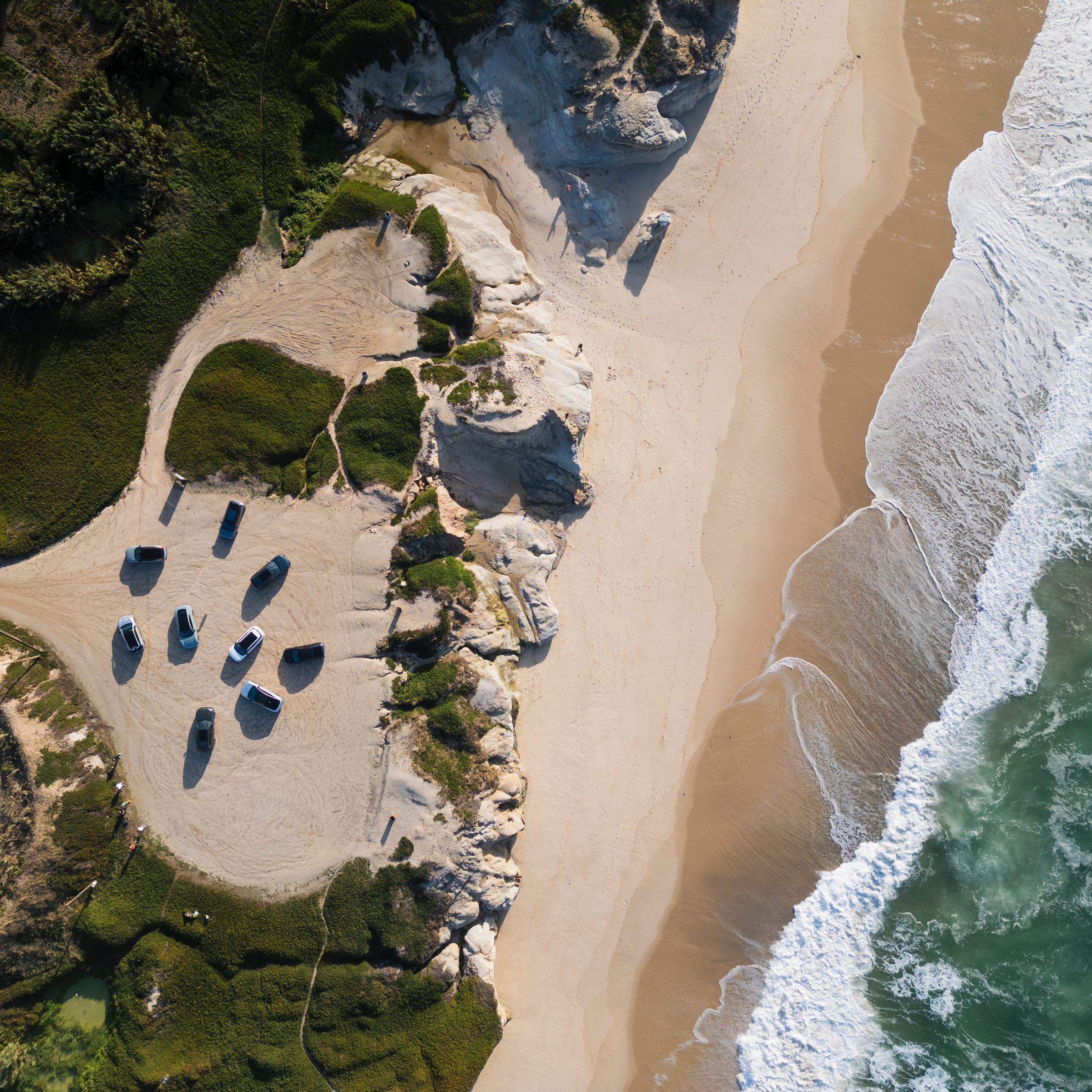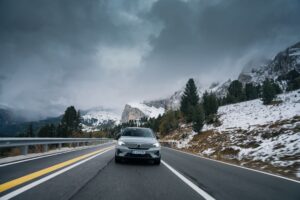When the Monasterio de Bolsaña, the monastery of Bolsaña, was built in the 17th century in the Huesca region of Spain, just below the Achilles’ tendon of the Pyrenees, few to zero citizens thought that almost three centuries later, in 2024, eight electric cars would silently, one by one, on a dizzy evening, silently, on a steamy evening, awakened from the asphalt by the cold rain, enter the cobbled parking lot surrounding the monument – now a hotel.
The last slice of rest awaits us before a journey of more than a thousand kilometers, the last leap towards a slam dunk that we have been aiming for since the first day of October, when we set our sights on Portugal after 10 months of training and logistical, legal, organizational and all that. From the outside, the effort is invisible. If you want to understand it, you have to be here. Or at least have a modicum of logic on your base board.
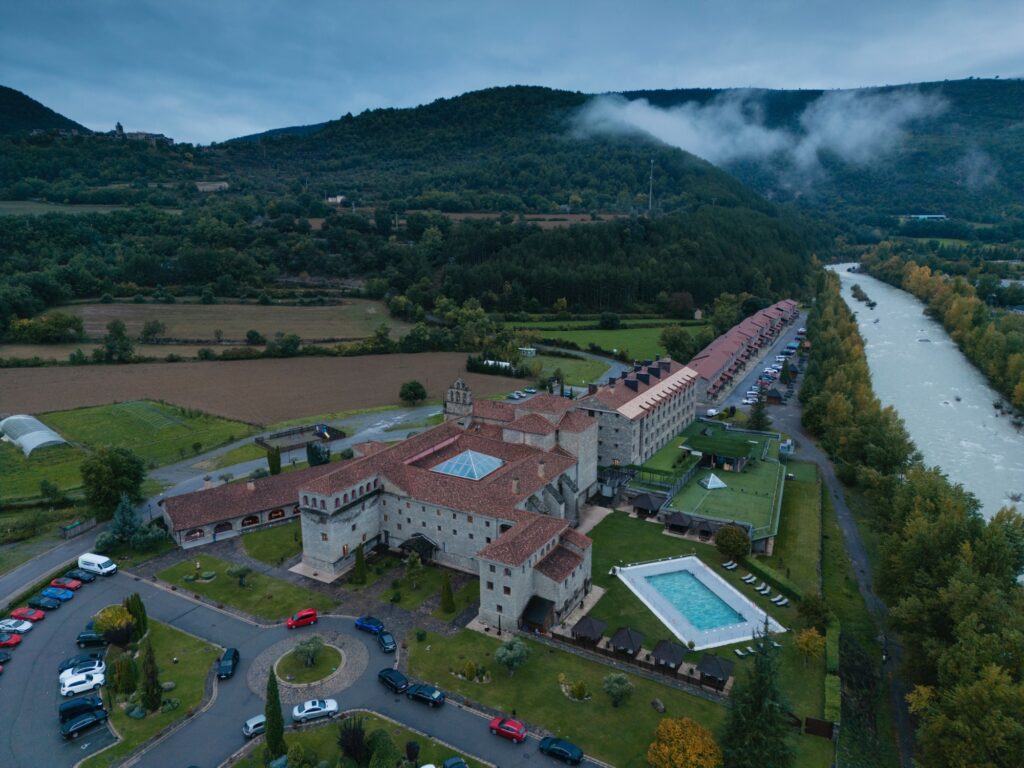

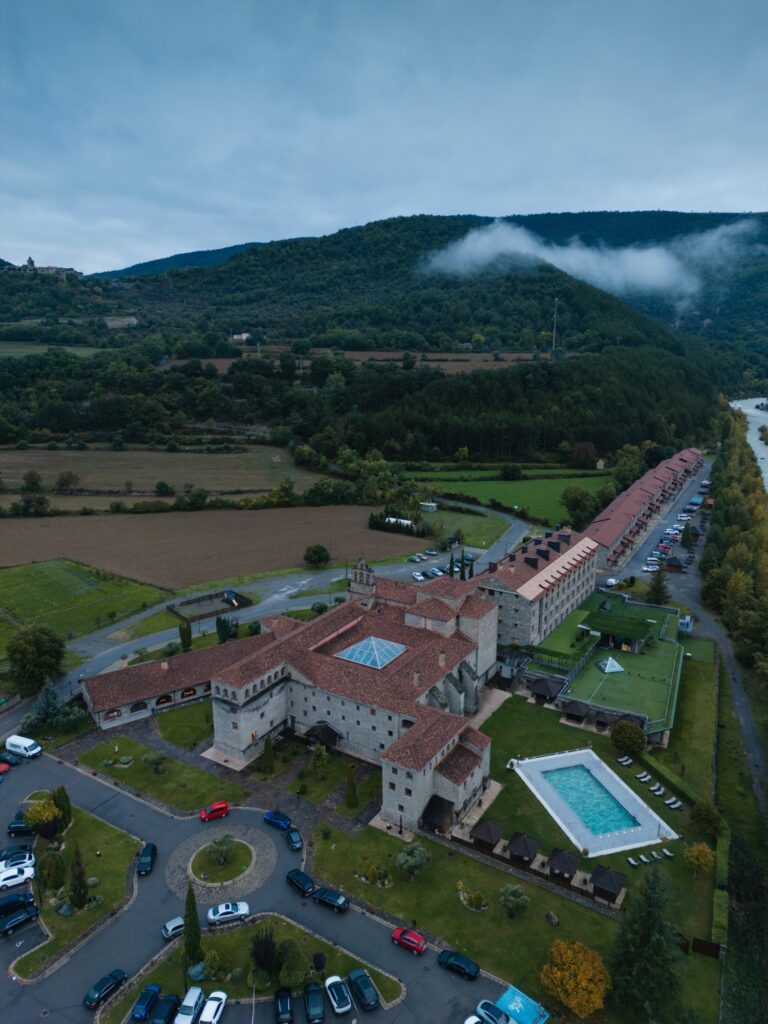
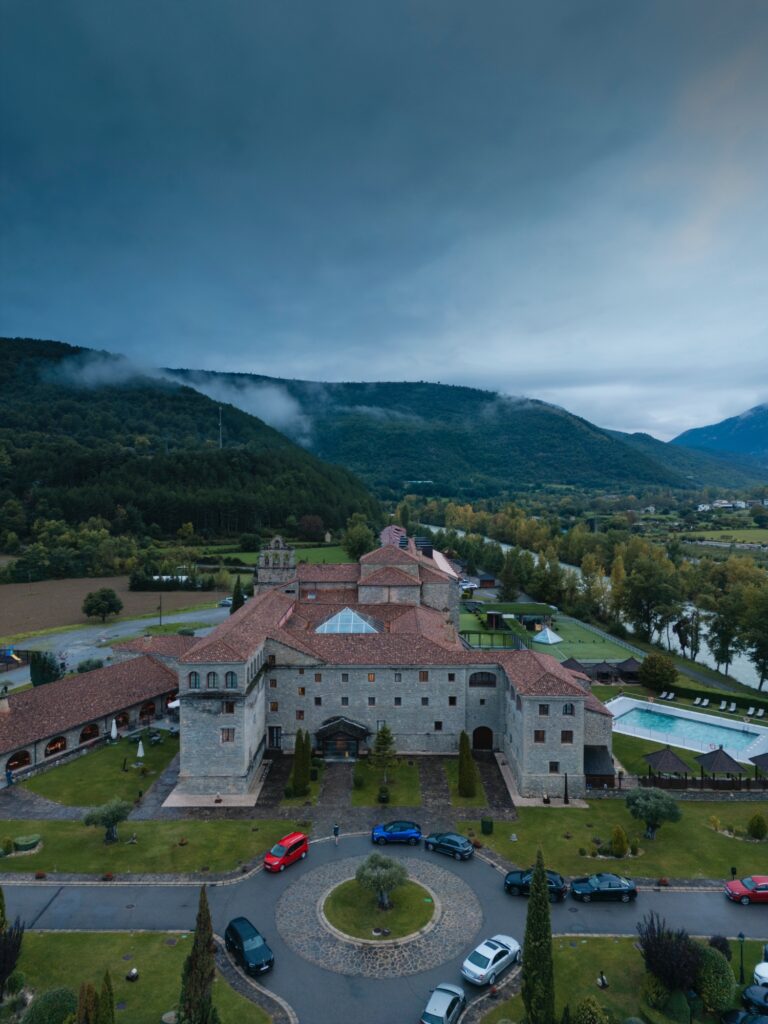
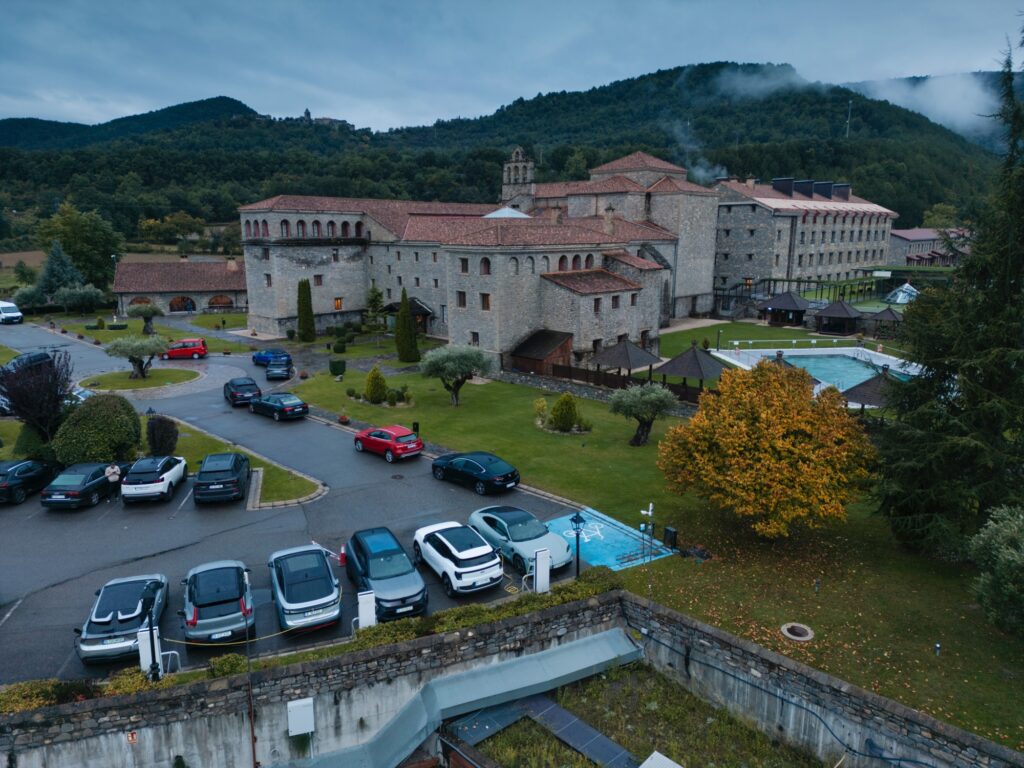
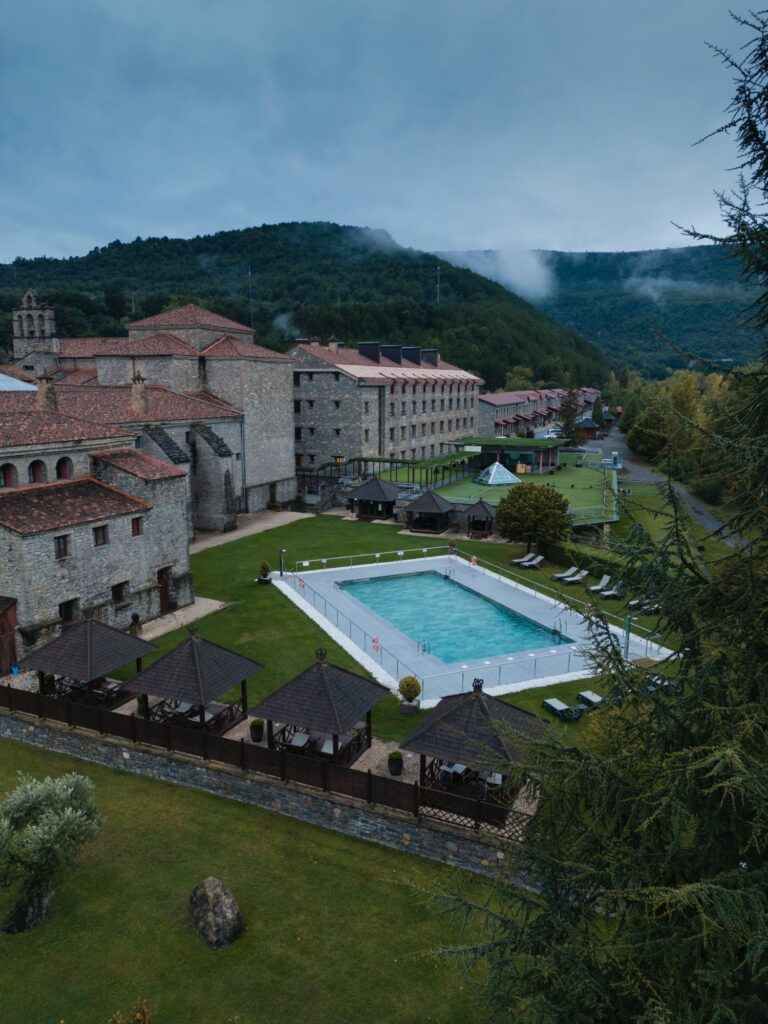
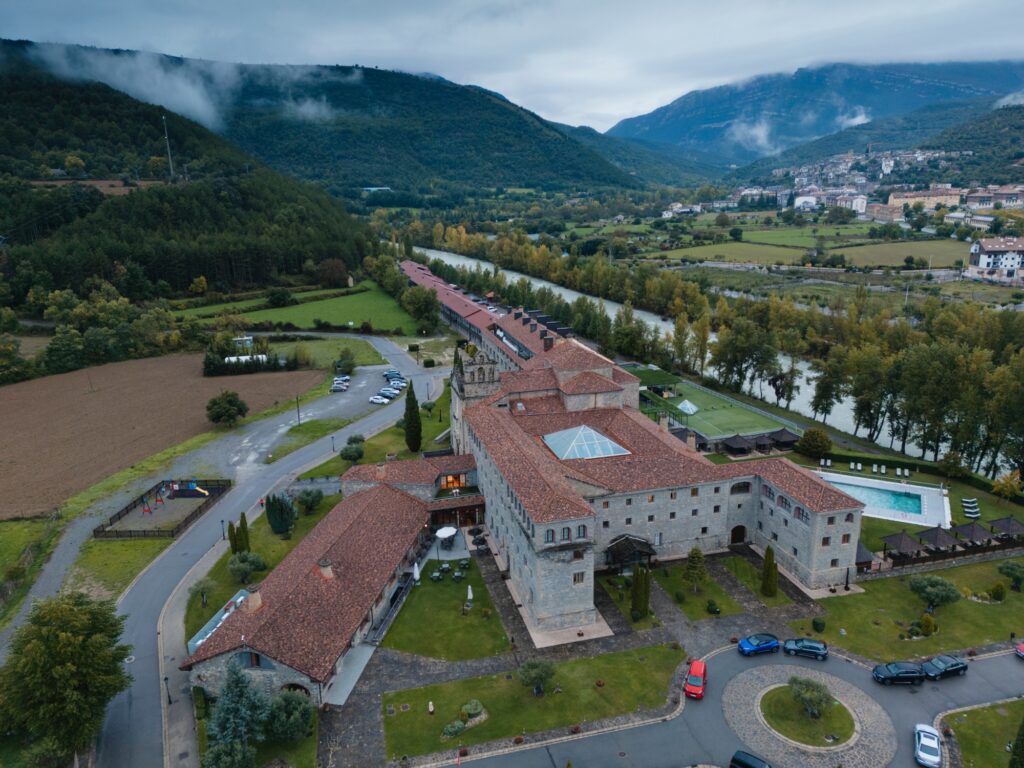
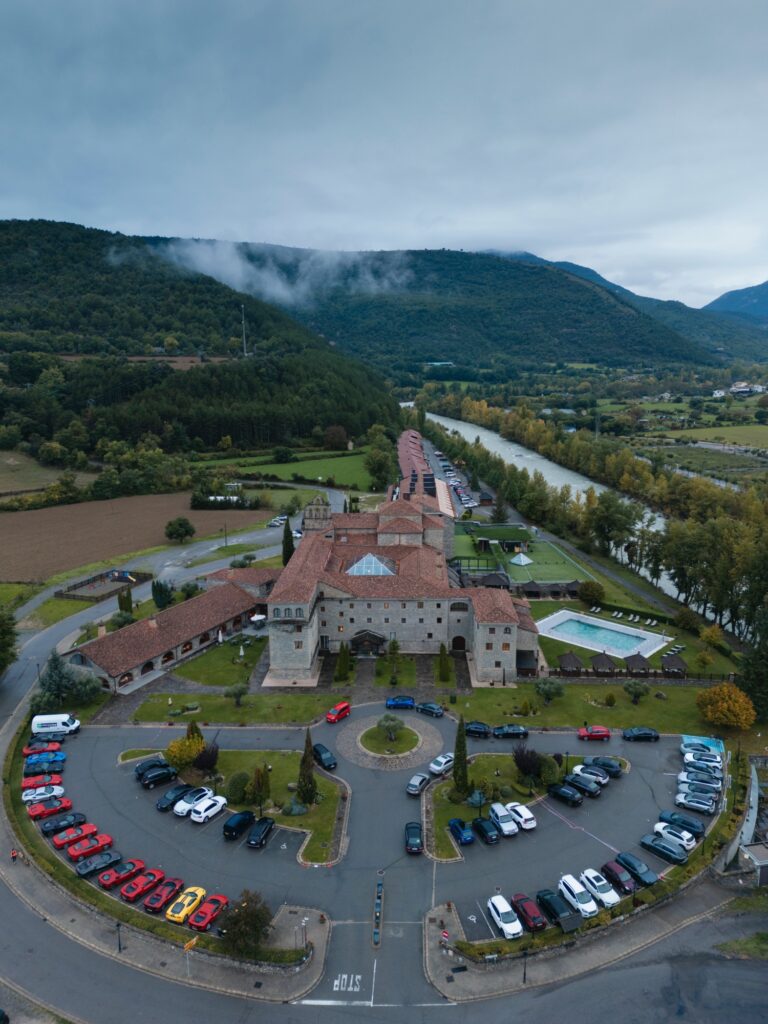
In the 17th century, the only tangible – and predominantly fatal – form of electricity was lightning. Today, you have it tamed, dissolved, packaged and delivered on demand in a black cable, about the thickness of a calabash, with a plastic handle on the loose end. From here, the lightning flows into a battery capable of carrying you, more or less quickly, more or less efficiently, to (almost) any destination.
We in EUROCHARGE are heading to Lisbon. From Bucharest. With eight electric cars.
Wrong.
We in EUROCHARGE have arrived in Lisbon. From Bucharest. With eight electric cars.
Forward
It’s the first time I’ve cut so deep into Spain for so many kilometers. How satisfying.
Sometimes, the landscape looks like a Dobrogea remixed with more aridity, multiplied and copy/pasted next to the highway that climbs, meanders, descends through the plain or simply through the rocks that are waiting to spill over the parapet. As if some hasty engineer, anxious to get on to the next project, has decided that rock is easier to cut and carve than to drill, bore, mill and seal with a tunnel.
We go ahead.
The cars charge as the on-board crew decides. The options are a motley assortment, and the choice is as flexible as you can get. We’ve had on the road charging spaces with six 350-kilowatt stations, 12 350-kilowatt stations, eight 150-kilowatt stations, two 200-kilowatt stations. Combinations of n taken by k, for anyone who knows numbers.

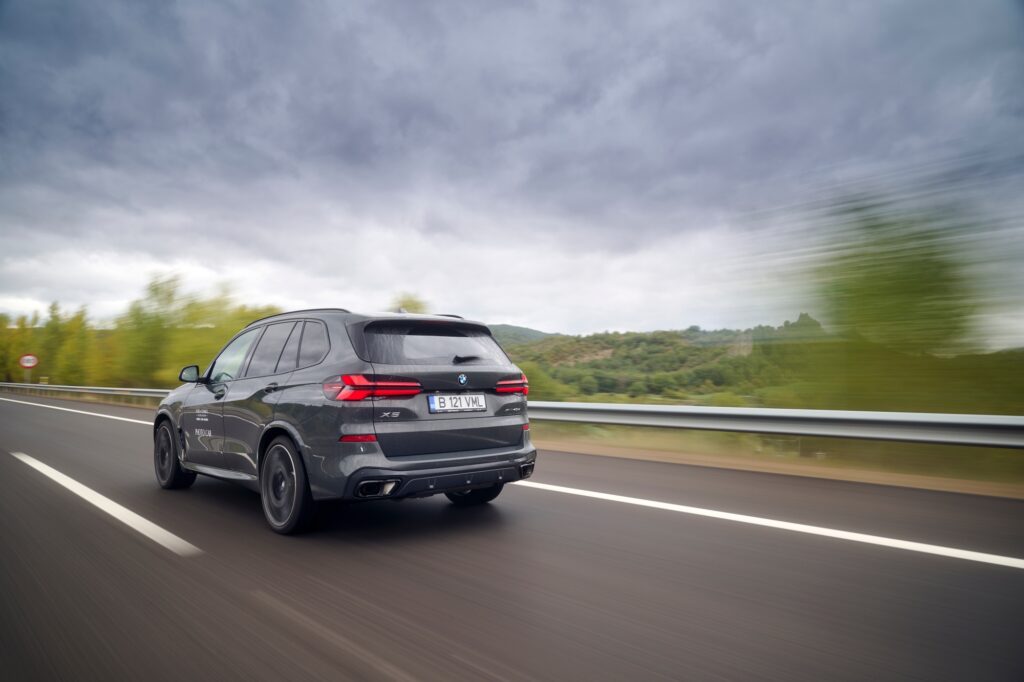
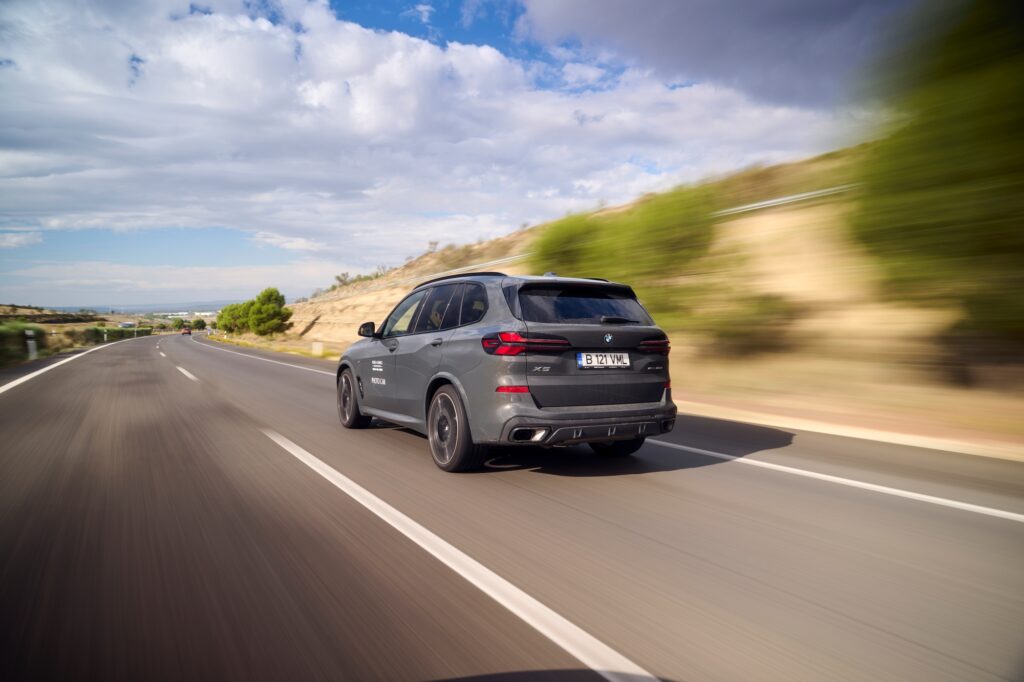
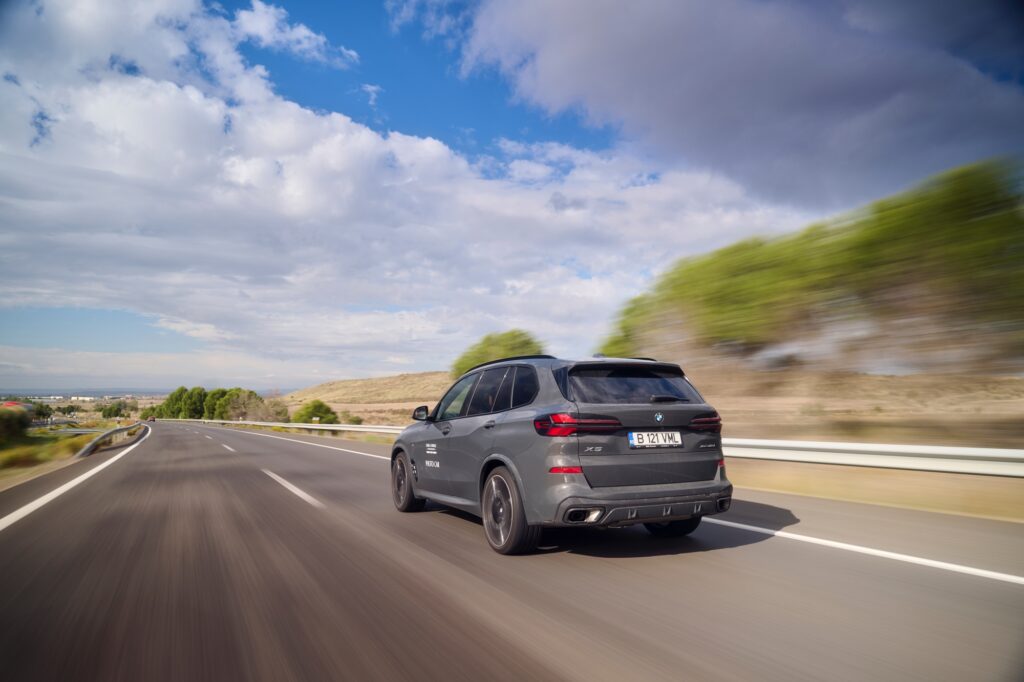
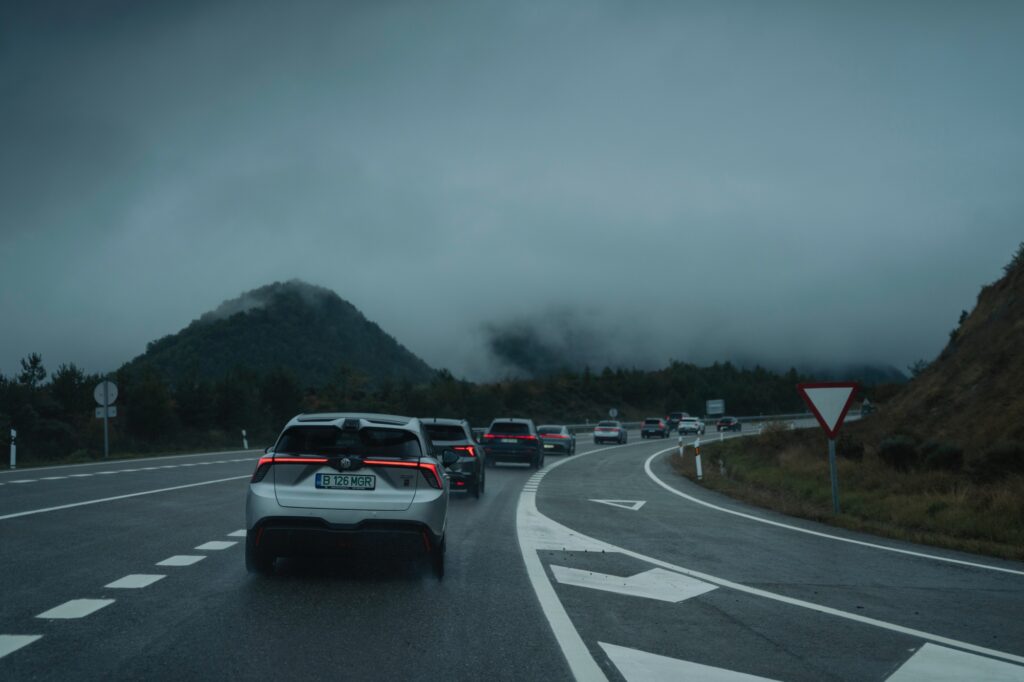
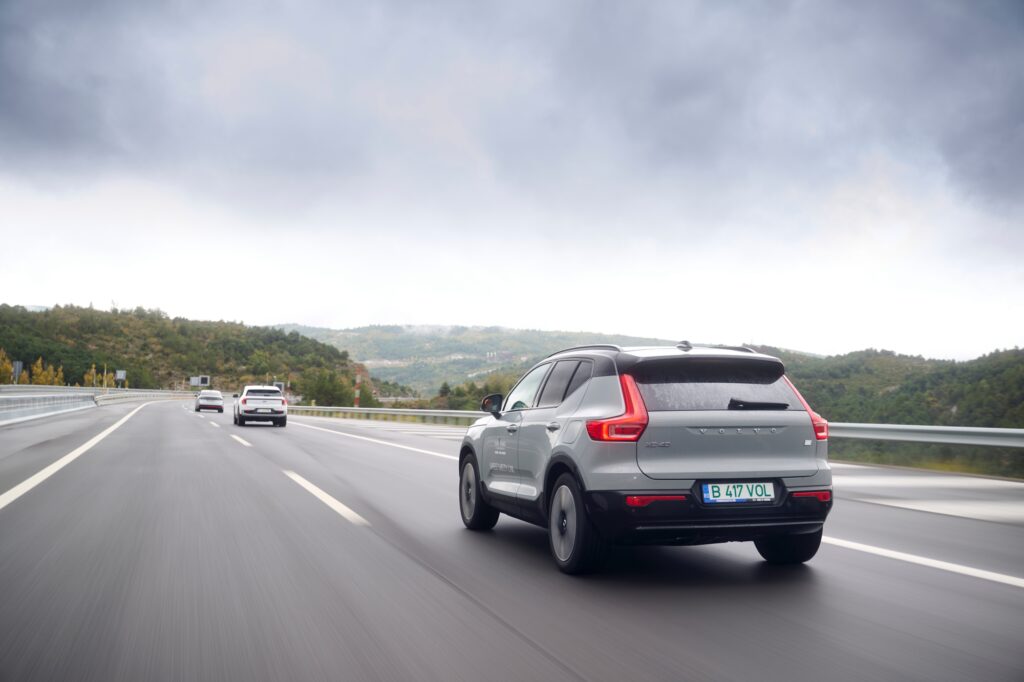
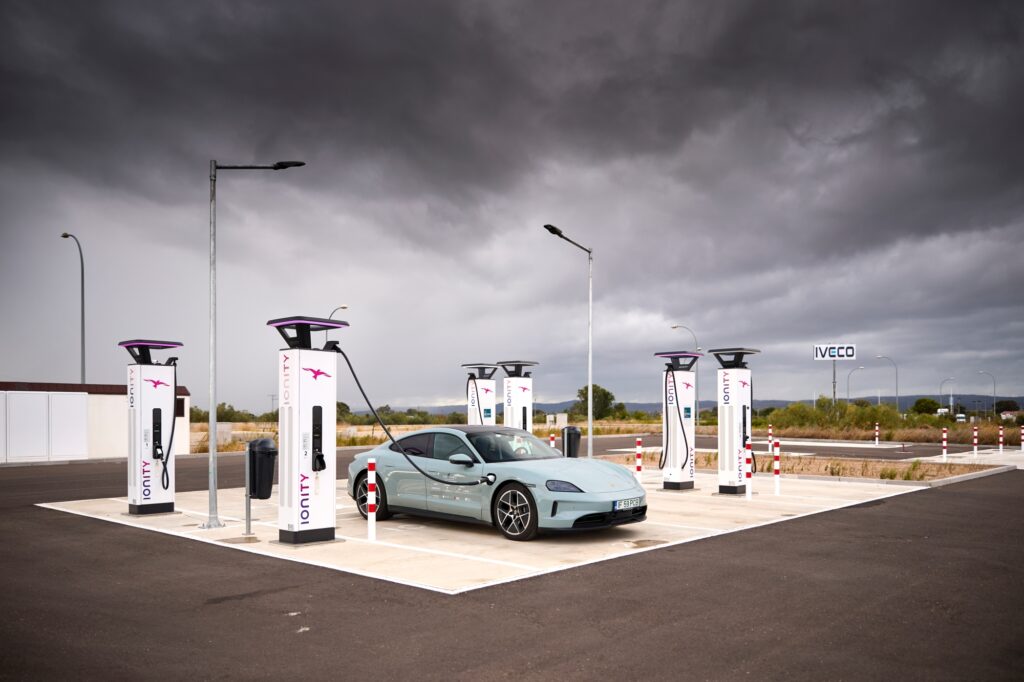
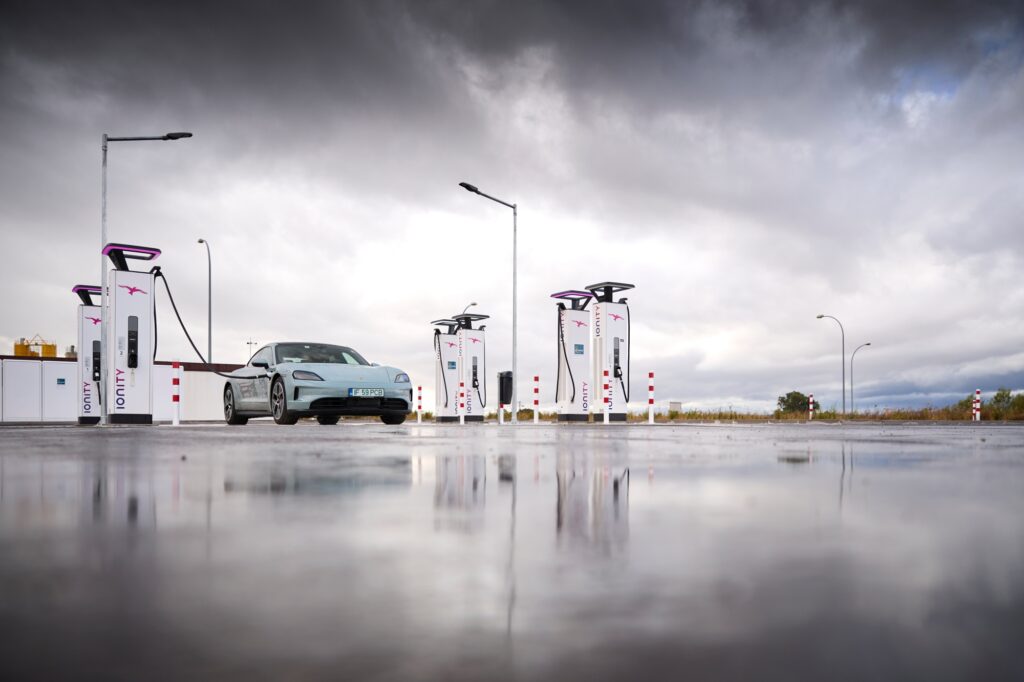
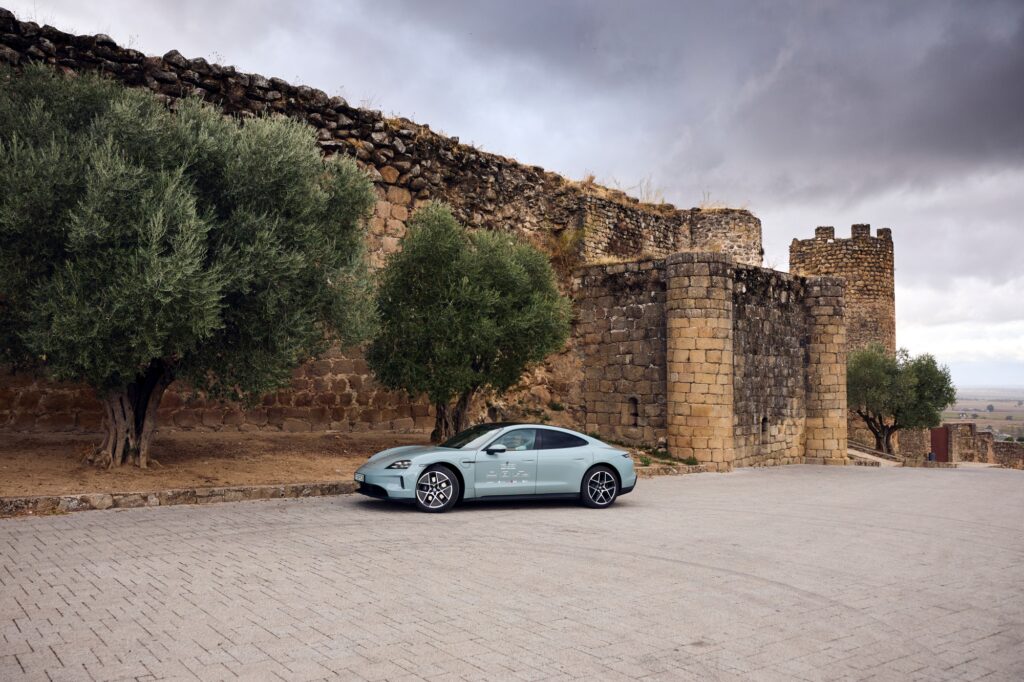

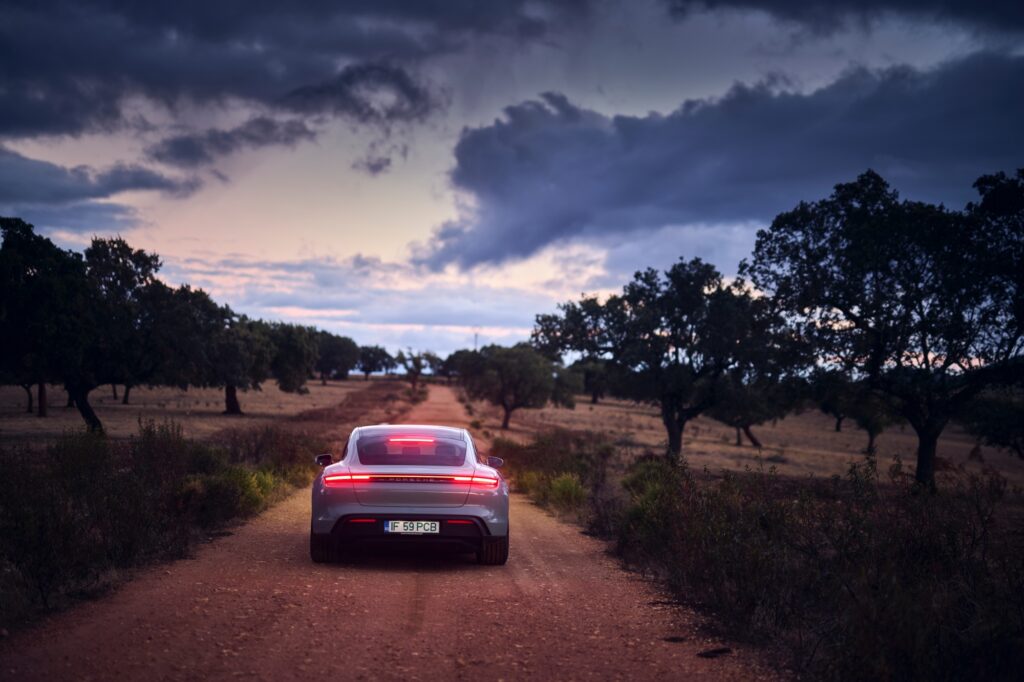
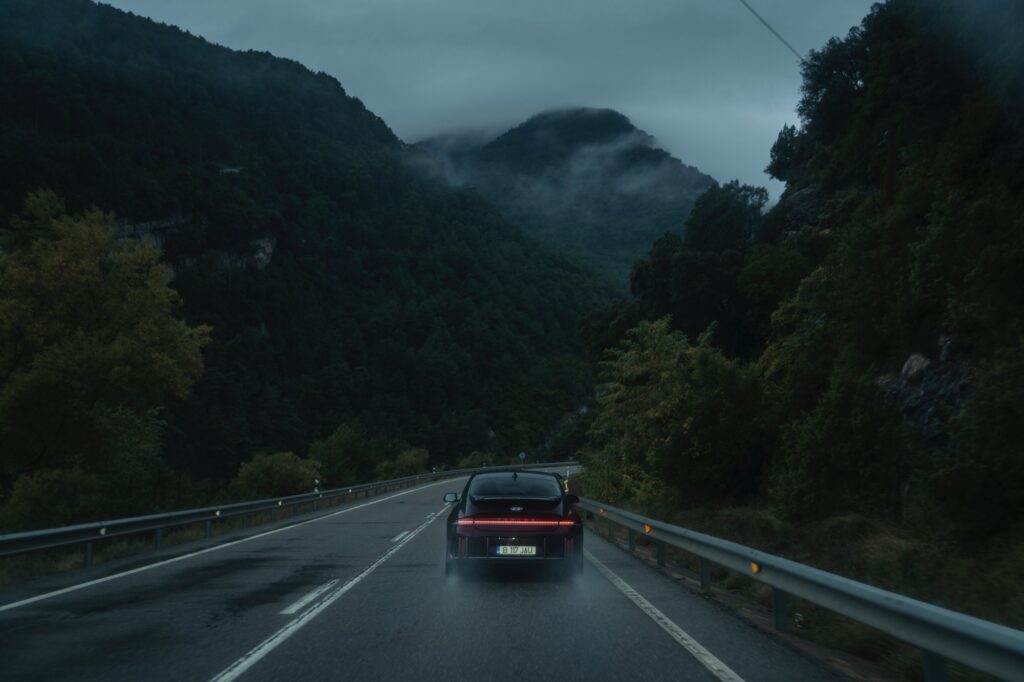
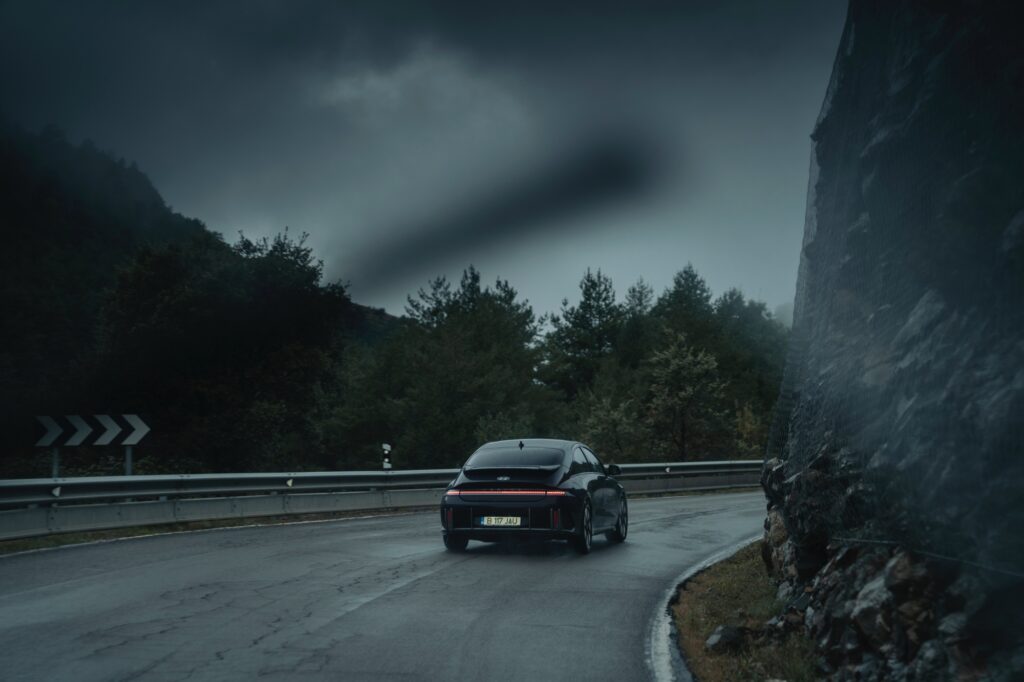
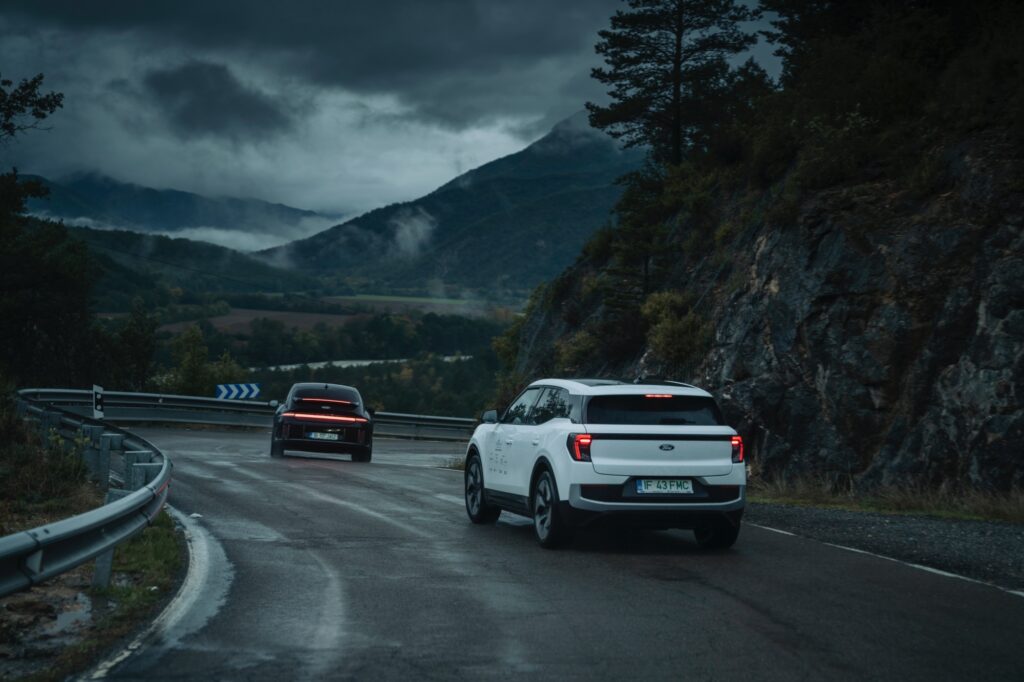
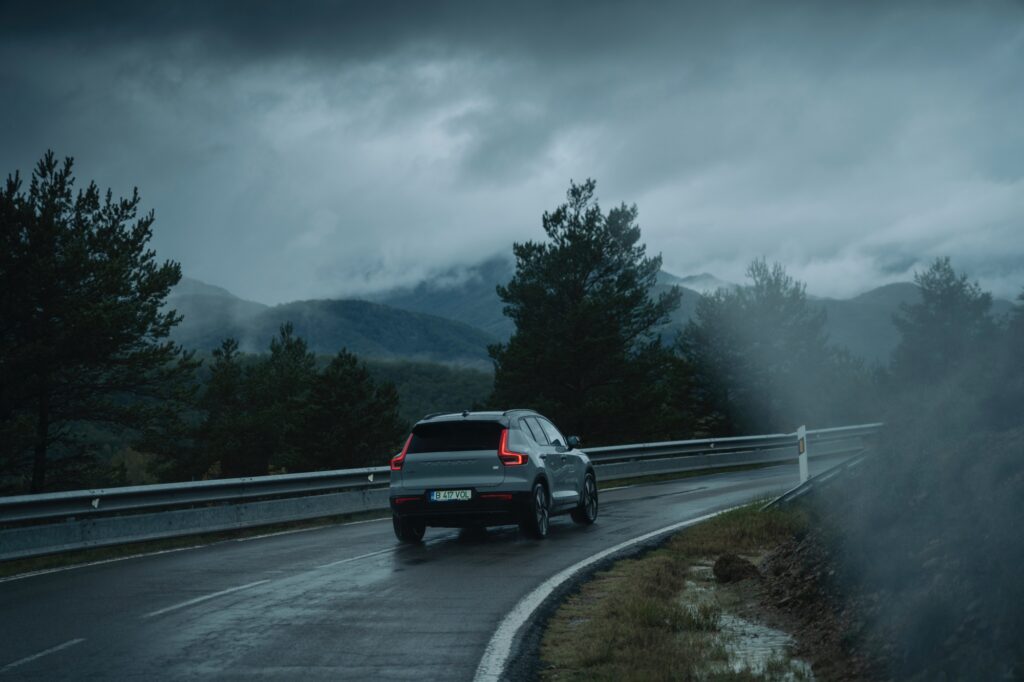
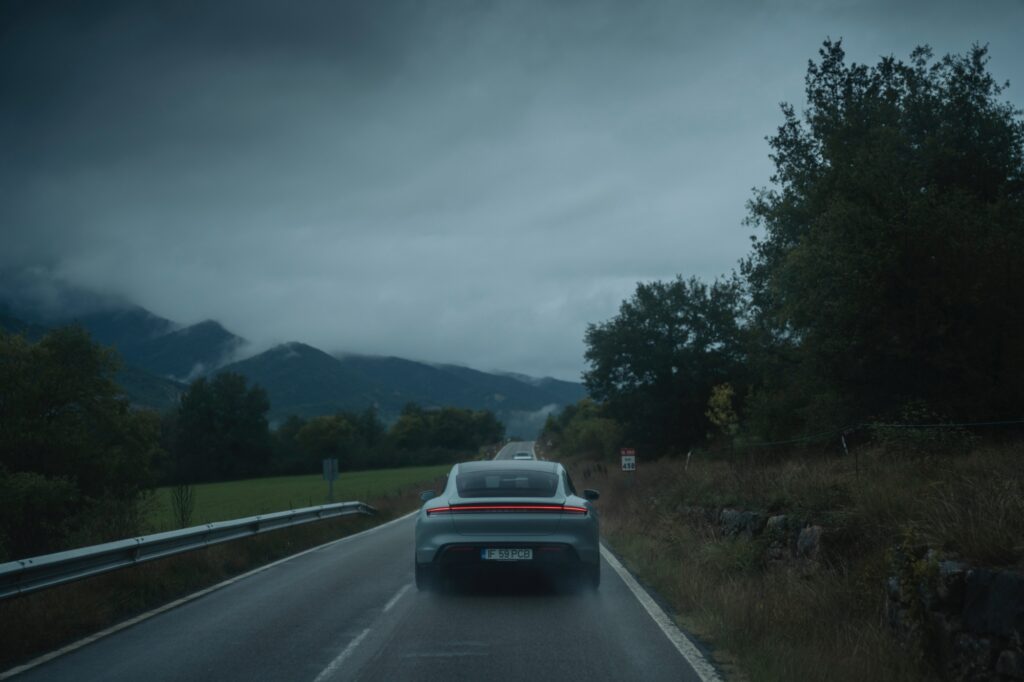
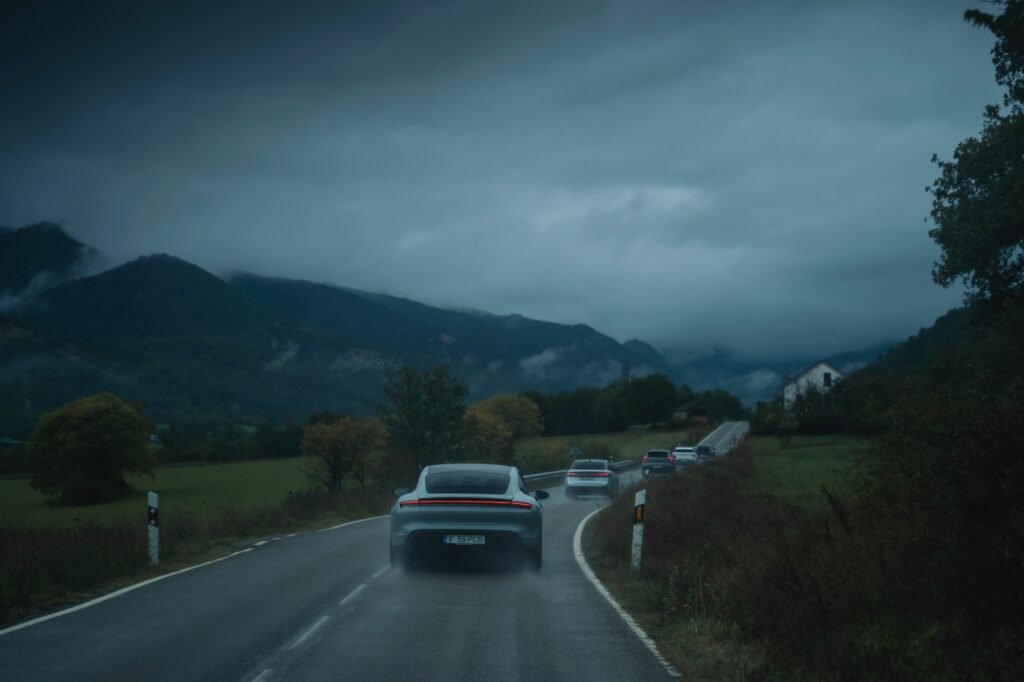
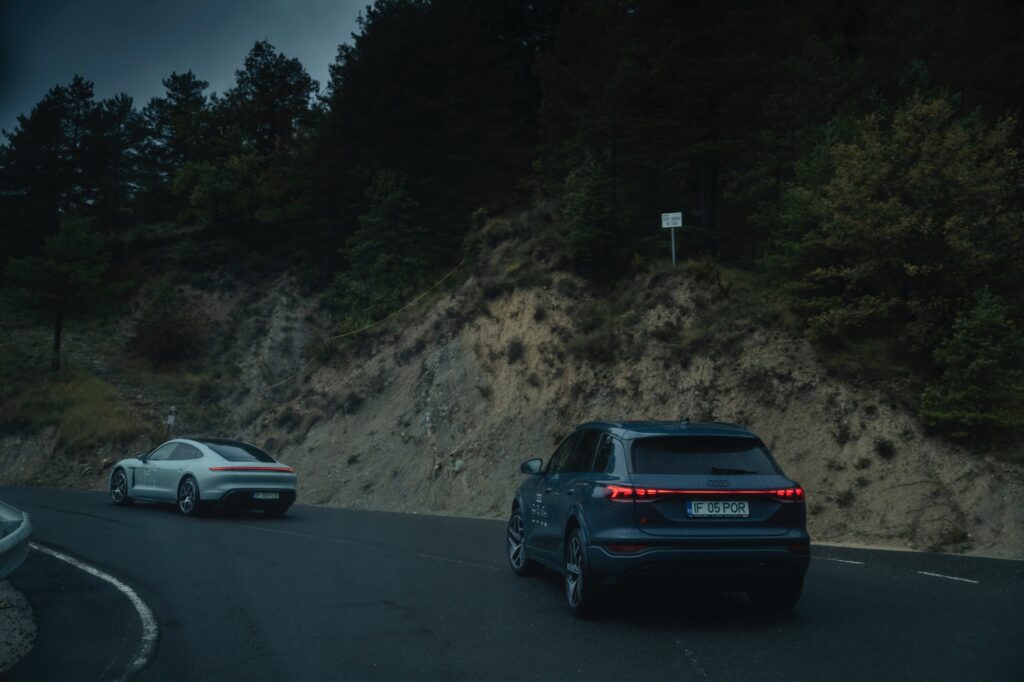
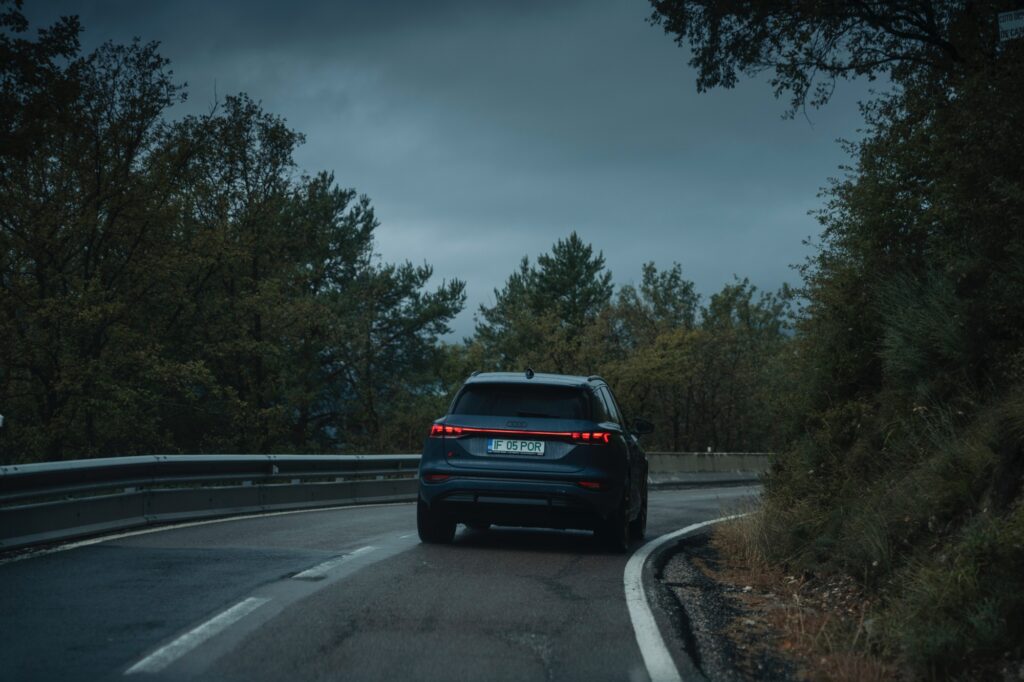
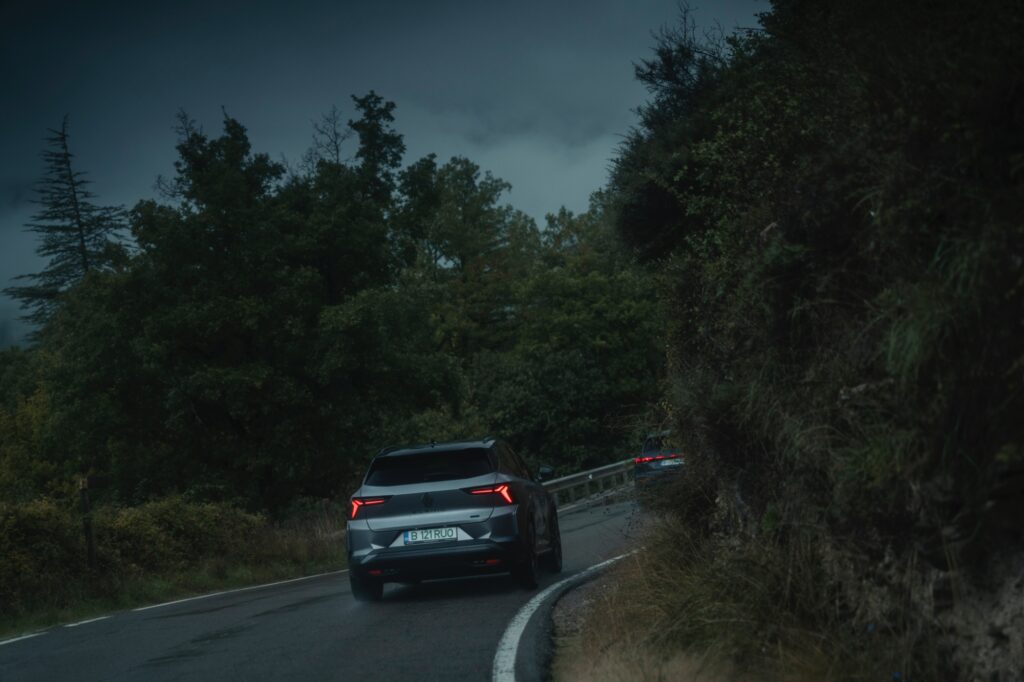

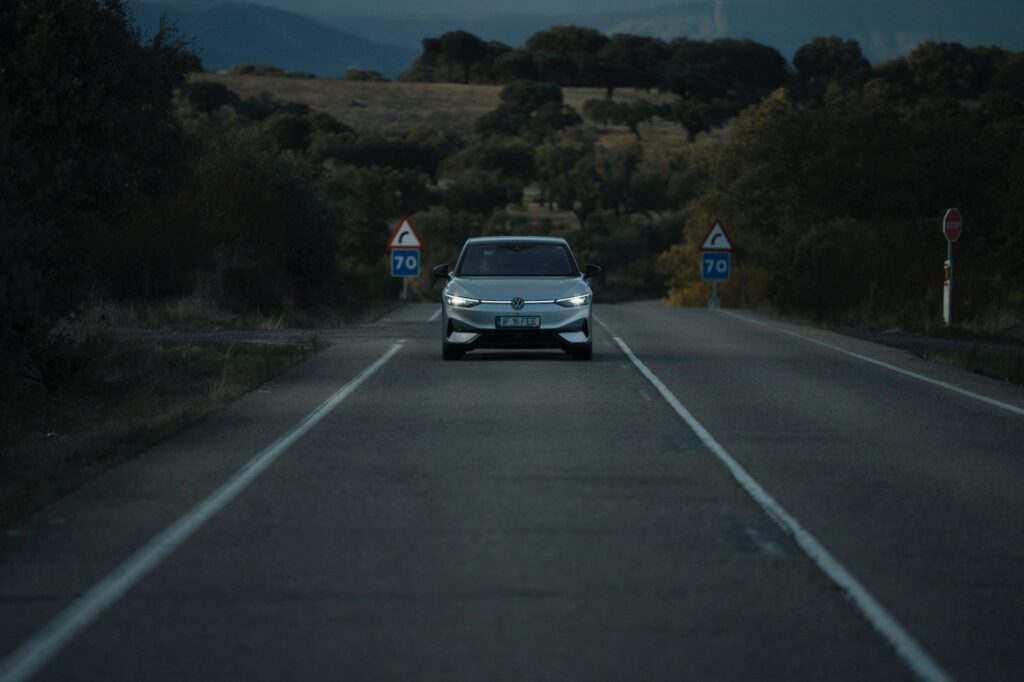
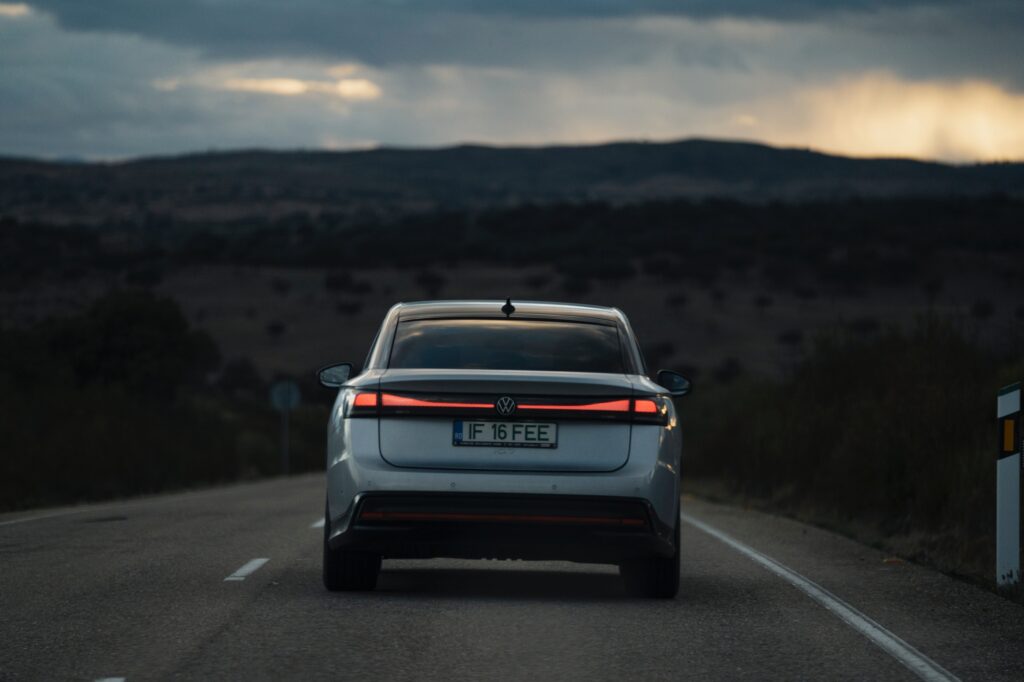
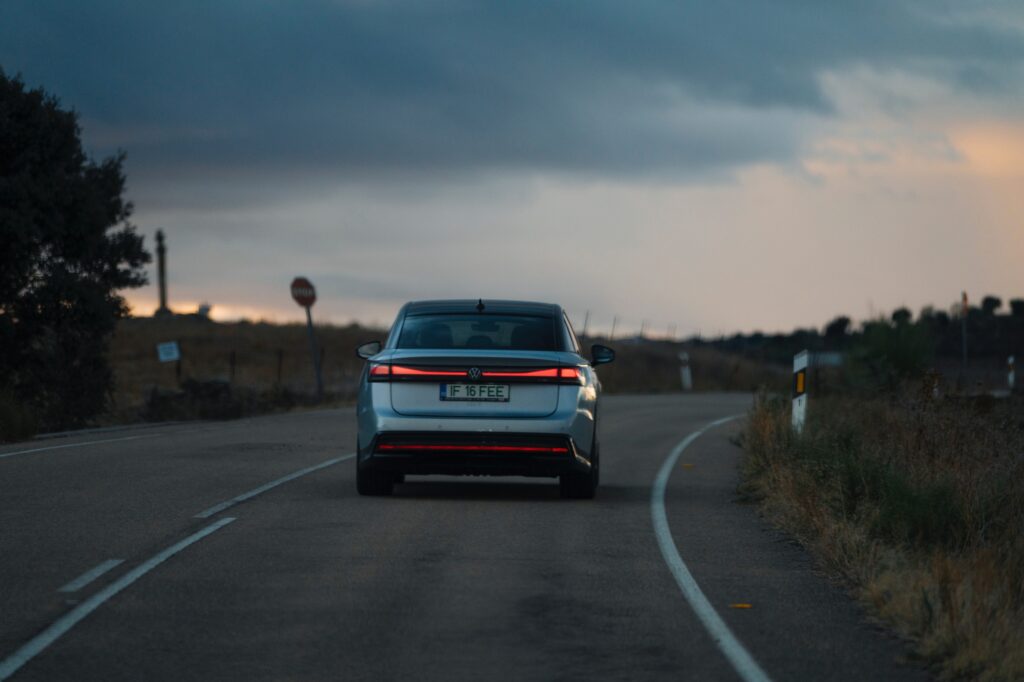
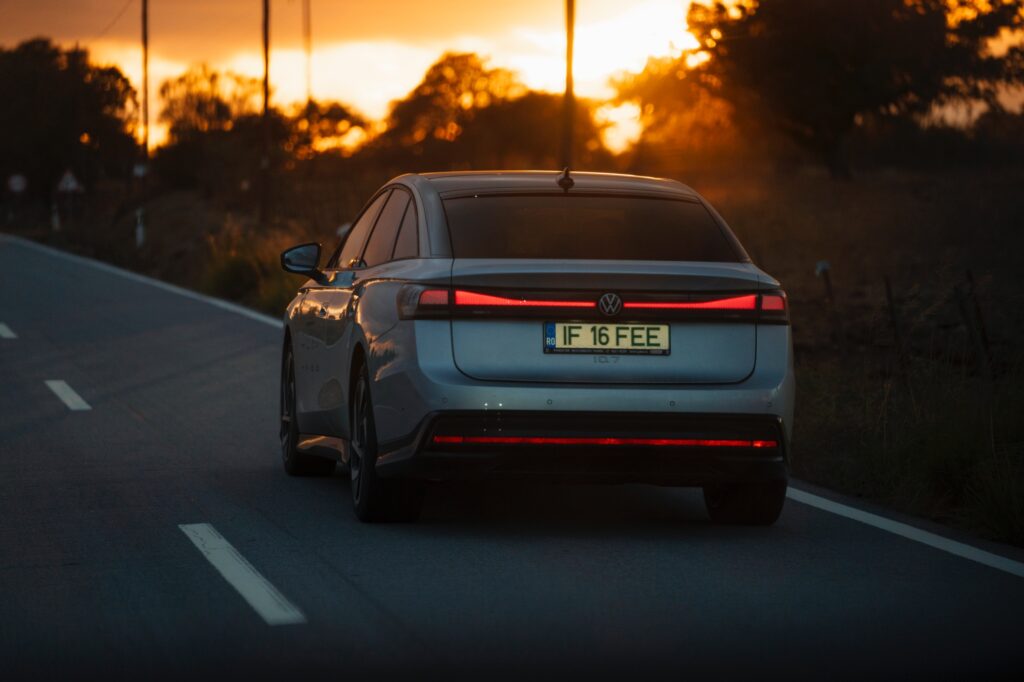
You can stop for a recharge at a station integrated into a Cepsa gas station – a metaphor in itself, echoed elsewhere, a testimonial that electrics, thermals and those who choose them can coexist in peace beyond the Facebookian Jihad.
Or stop off at a Ionity on Madrid’s ring road, across the road from a Corte Inglés, if shopping is life or if you’re craving the crisp atmosphere of the flat, rain-saturated landscape and gusty winds – naturally, vital to range and fuel economy.
Come to think of it, “The rain in Spain stays mainly in the plain” is not only a way of flaunting your impeccable Cockney accent, but also an axiom in these places, as we have perceived them now and in the past days. Hello, Constantin Ciobanu.
Welcome
Huesca, Zaragoza, Madrid, Plasencia, Castelo Branco, Peniche, somewhere above Lisbon. The route in its pragmatic version tells only a third of the story, no matter how far you lean over the map. The other third comes from the data you add up. The last is what you live with.

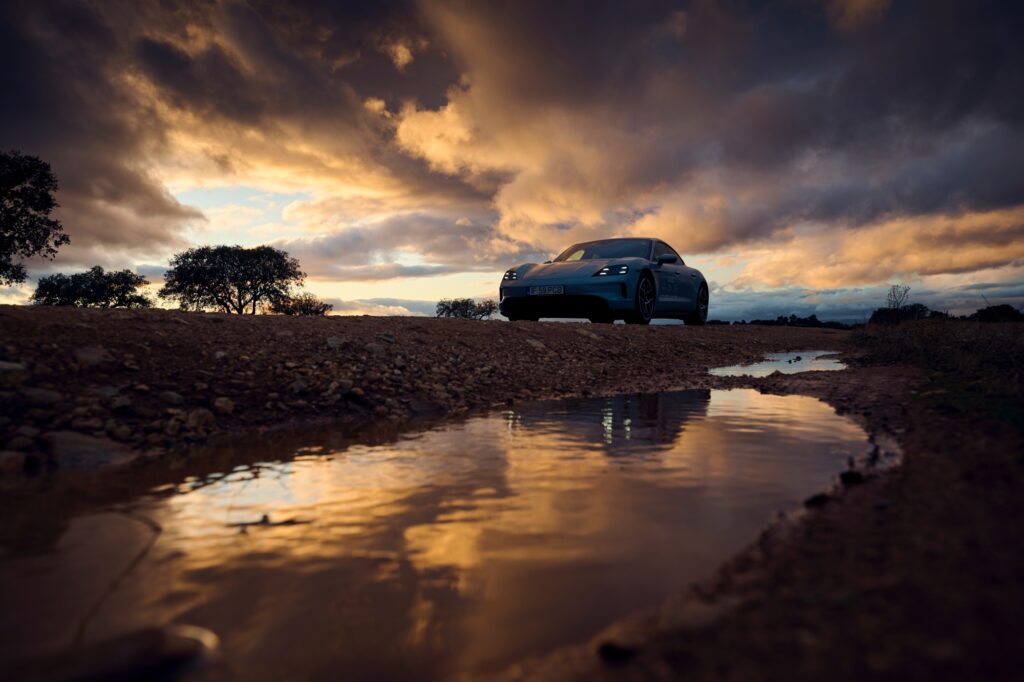
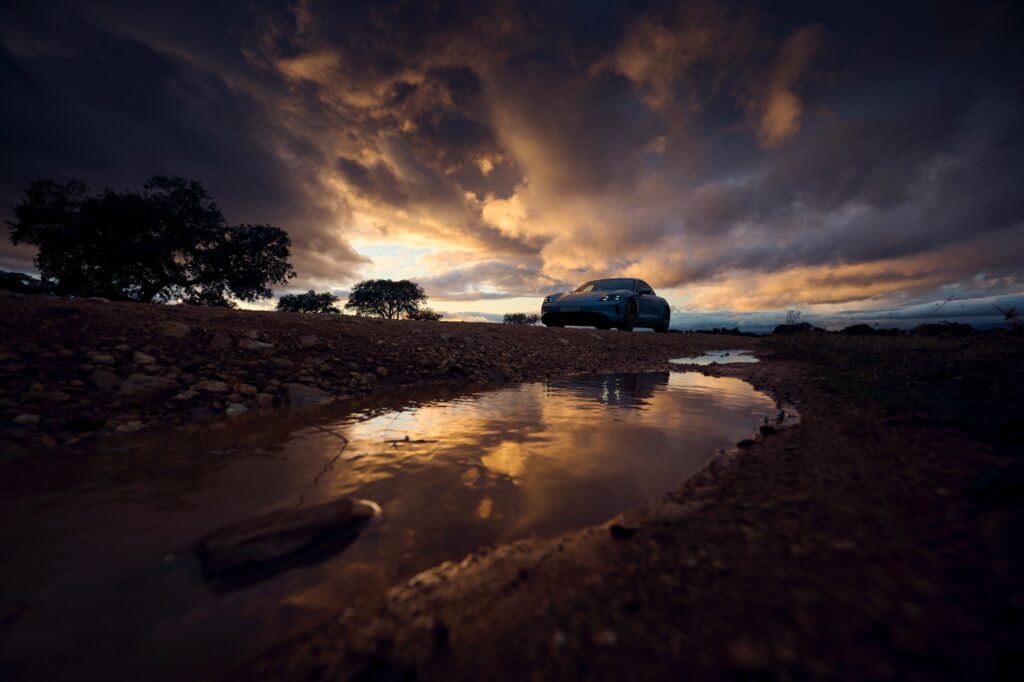
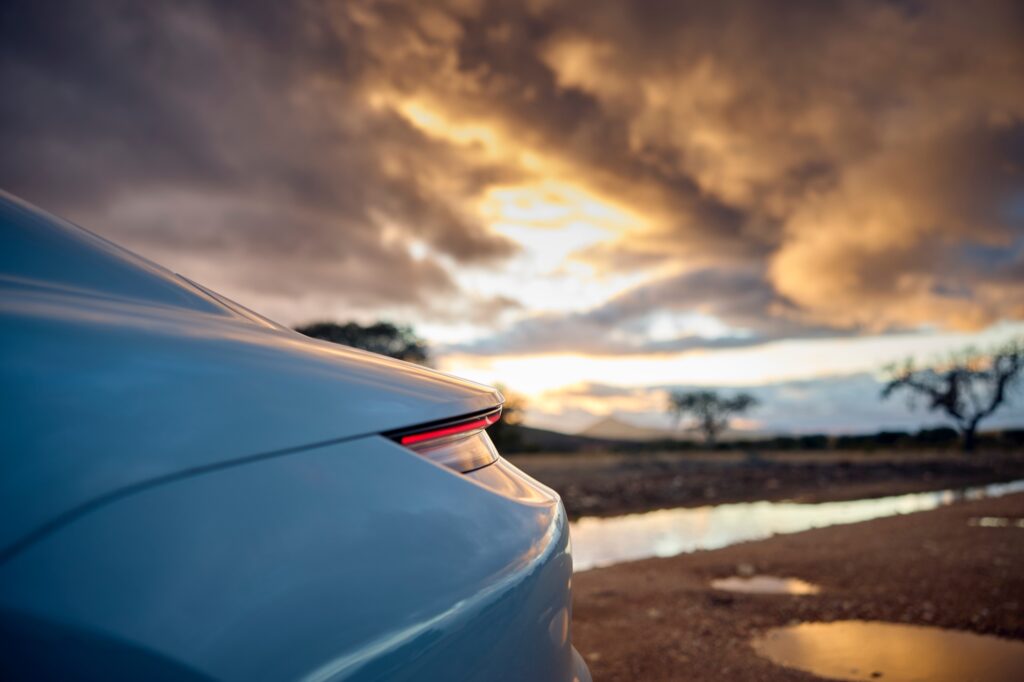
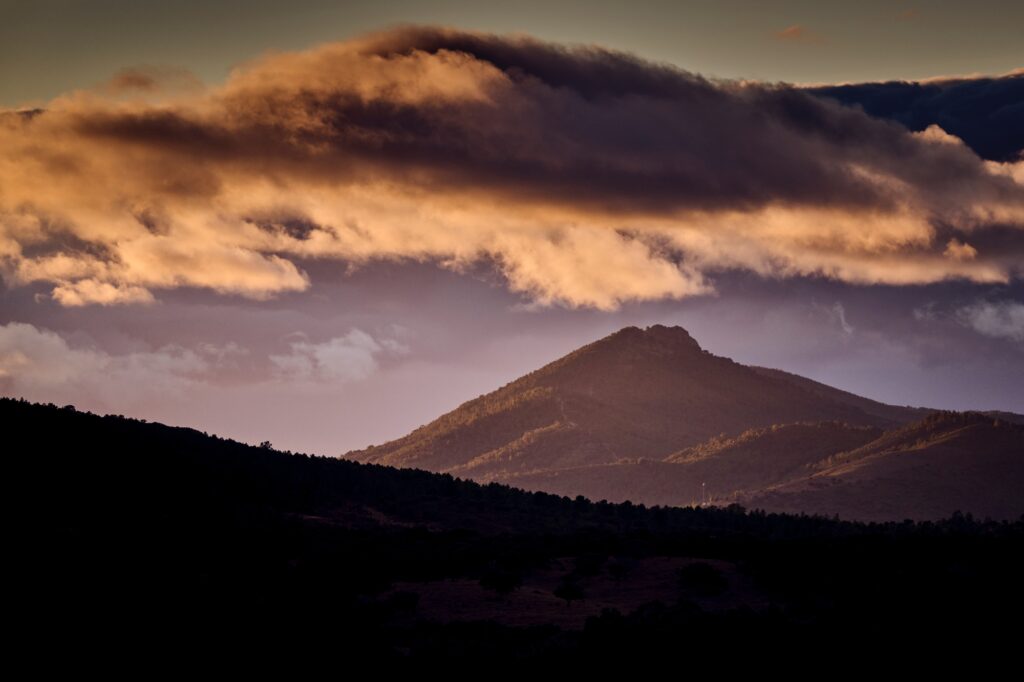



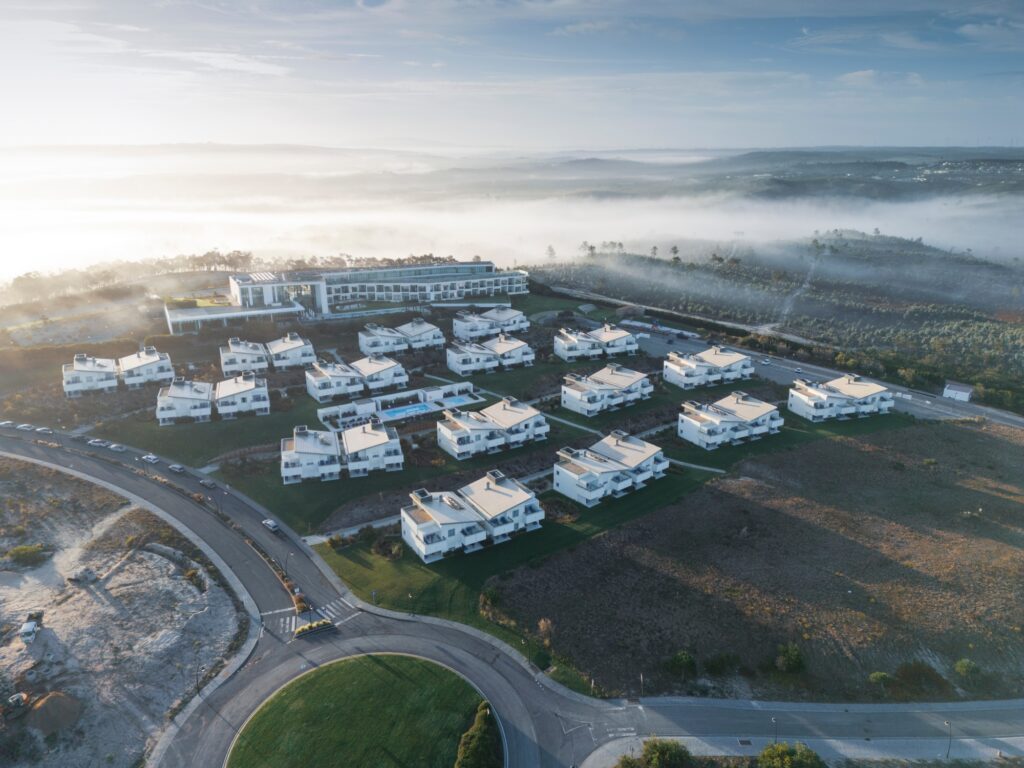
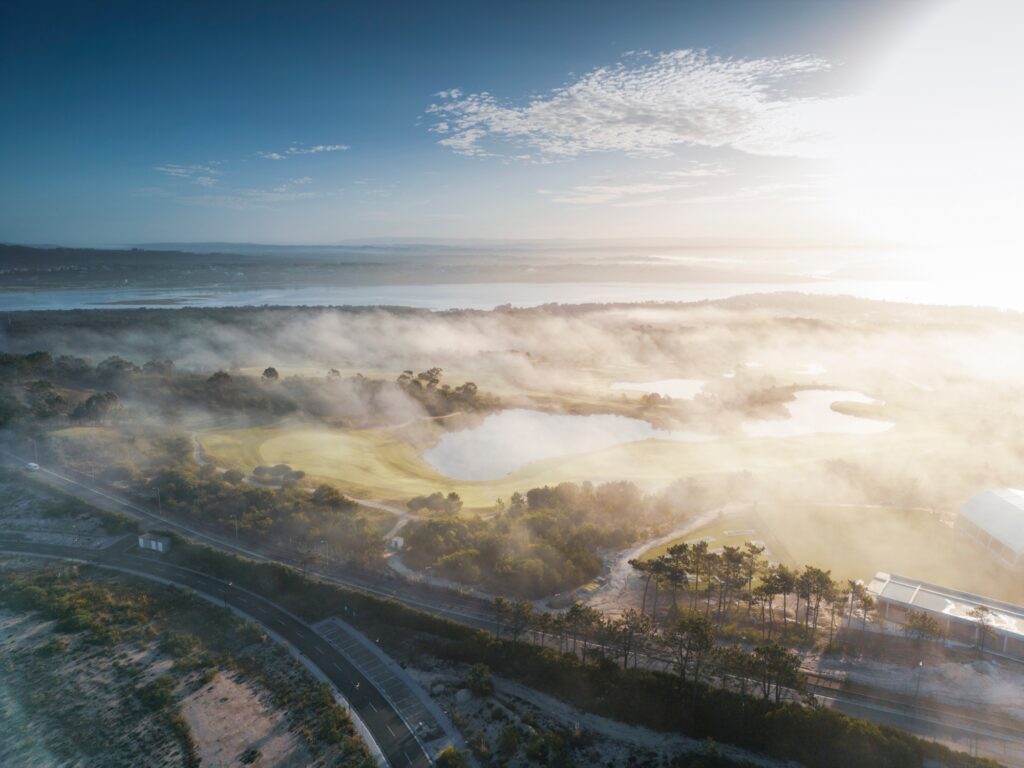

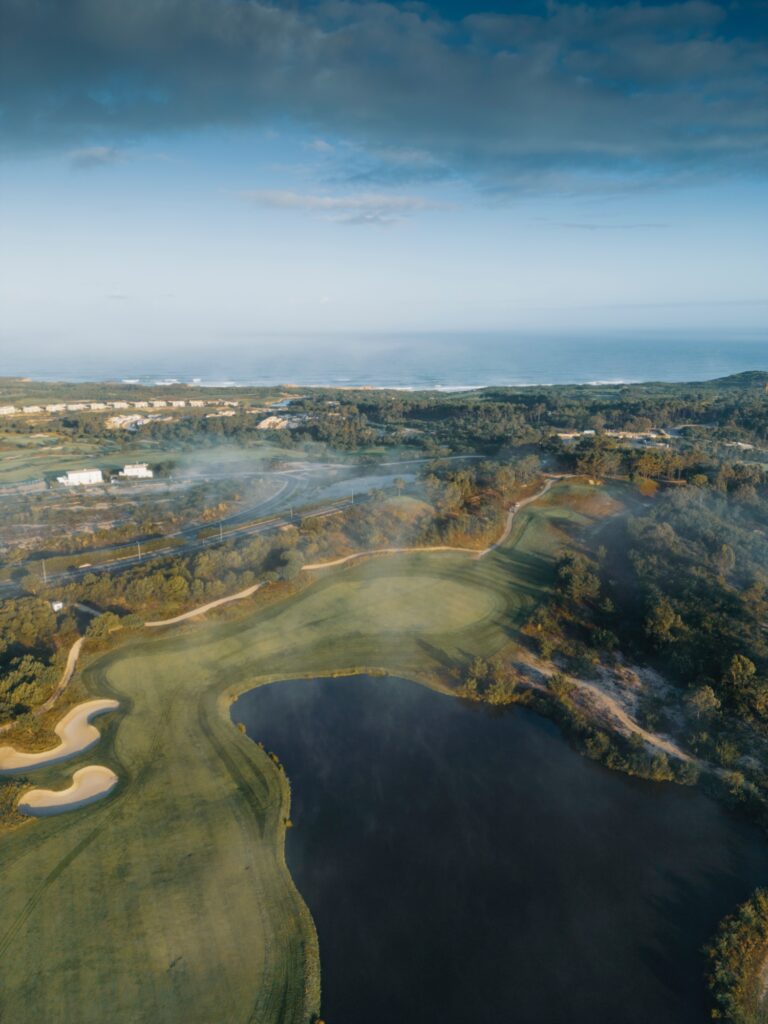




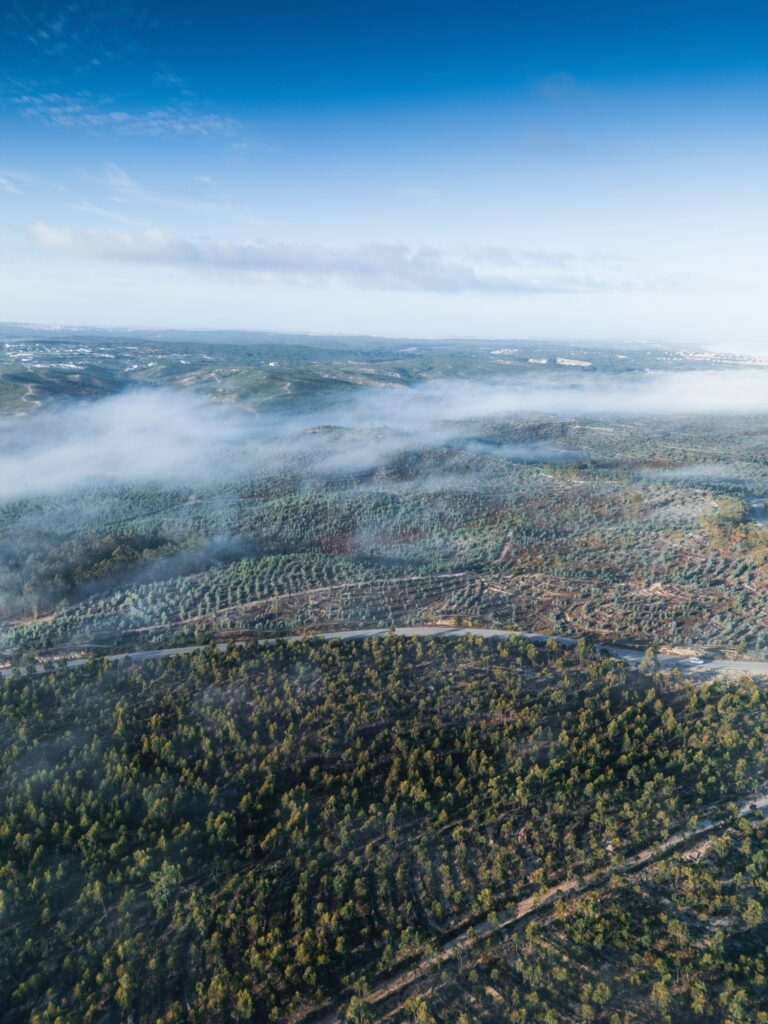

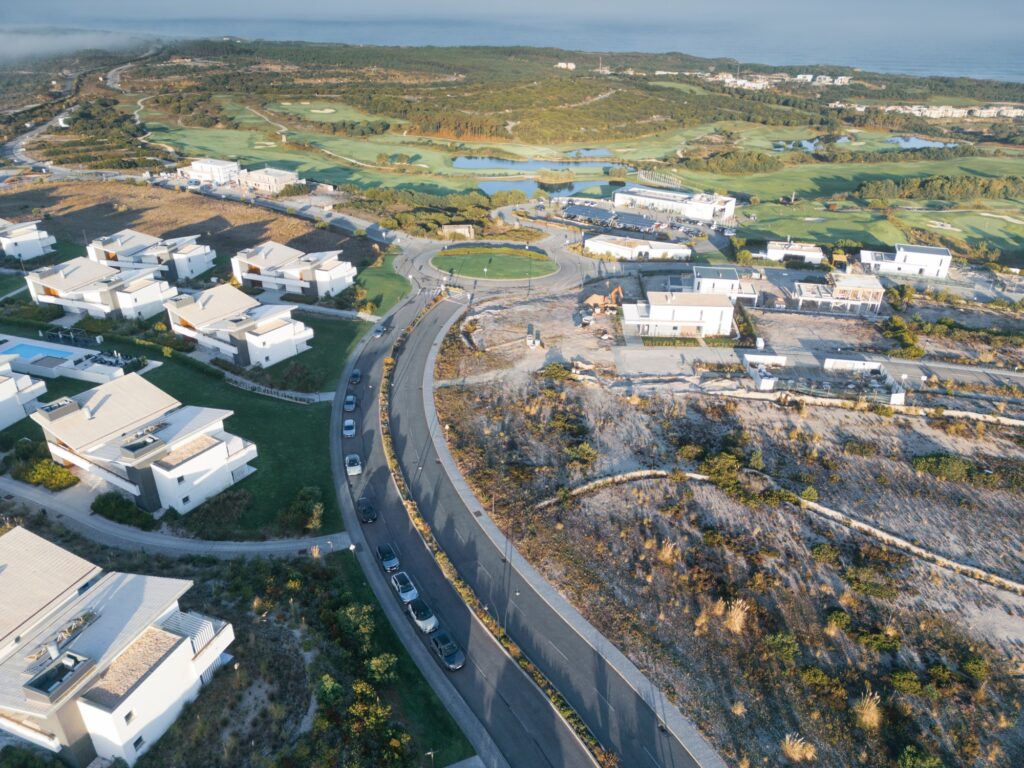
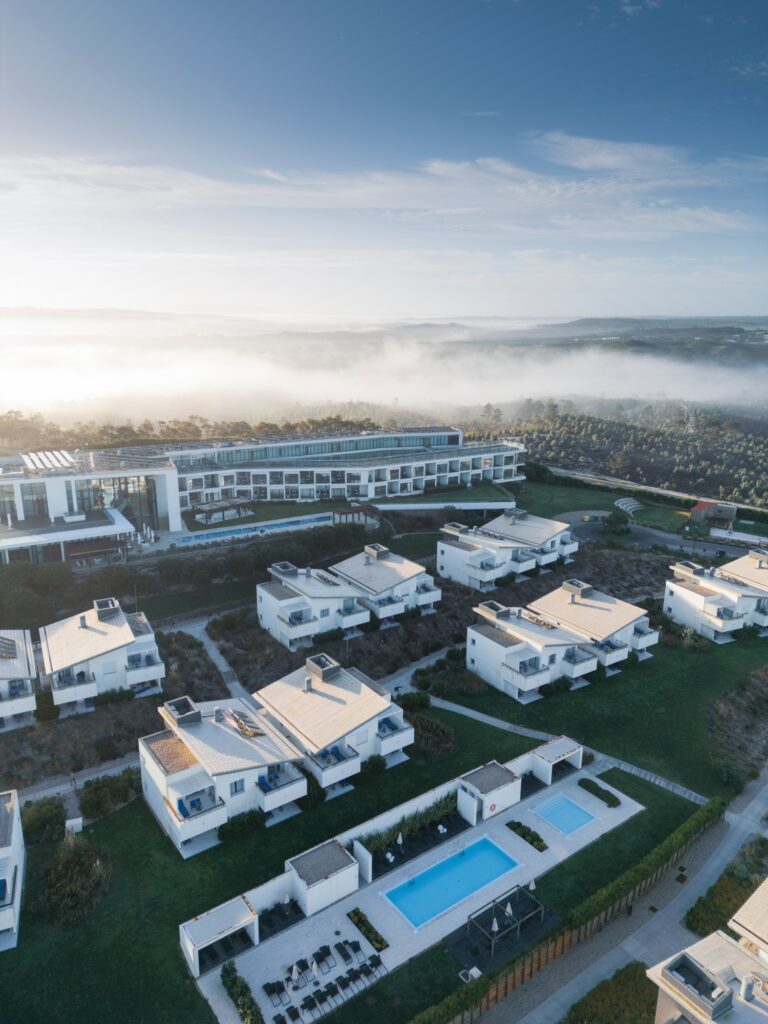
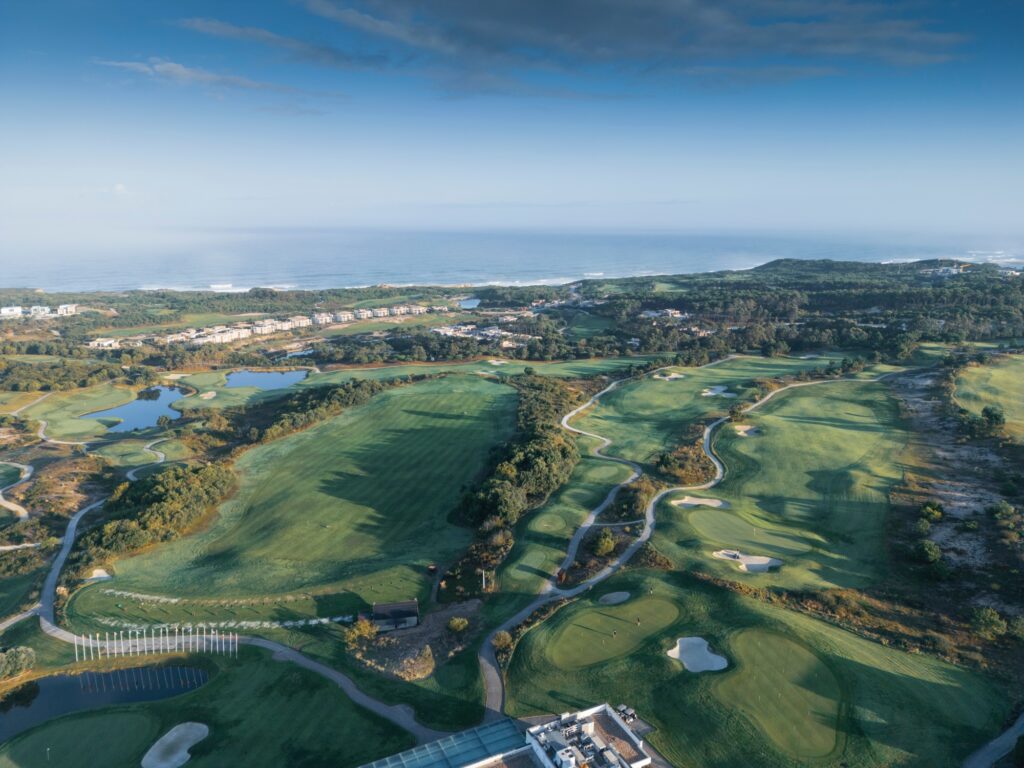
I’ll apologize at the outset, I don’t have an epic thread developed on that side yet. Just an amalgam of sequences, never chronological: the buzz of a gas station, the drizzle of rain on the windshield, shots on the move, the calm that a well-done adaptive cruise control gives you on a long drive, a sugar-free energizer sipped at a fuel stop, eight electric cars in a column on a viaduct, 22 degrees for the first time since I left Romania, a narrow bridge over an even narrower river, a bridge connecting Spain and Portugal.

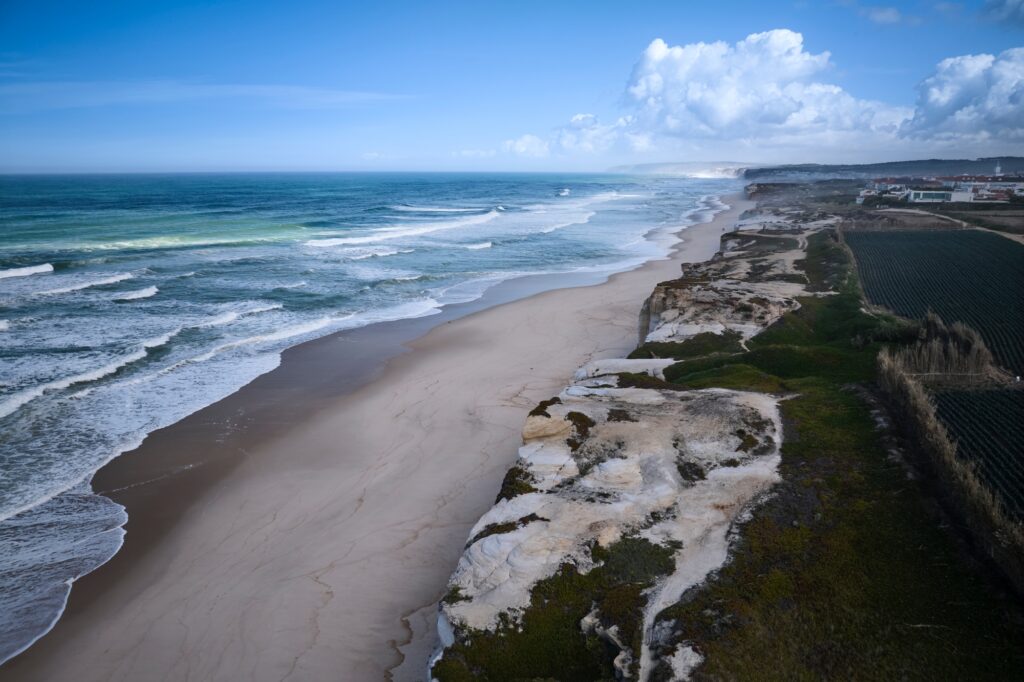
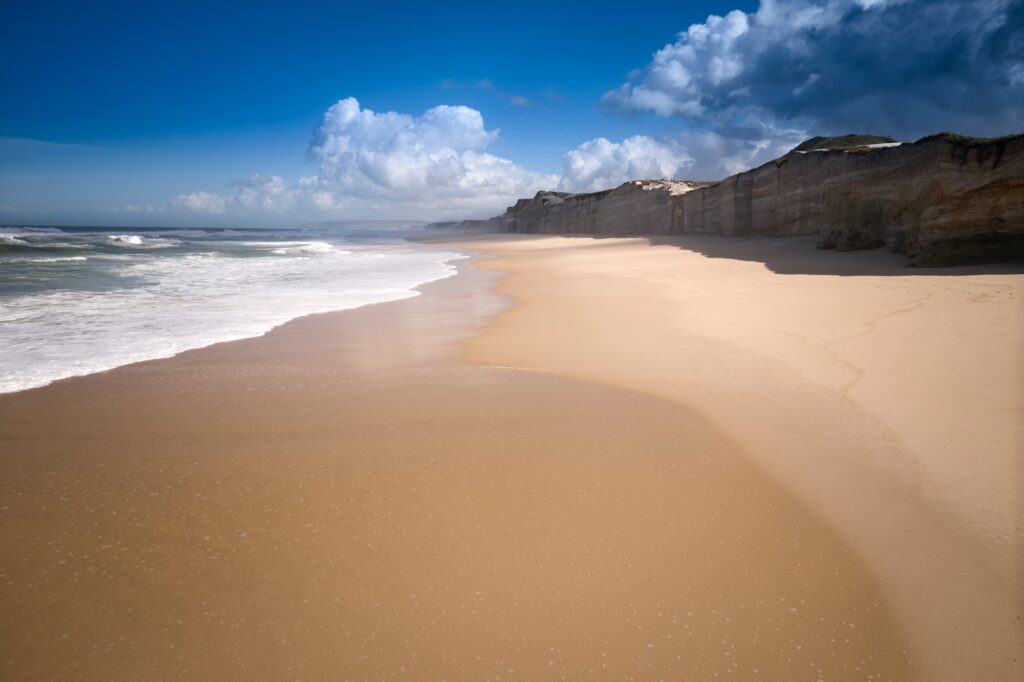
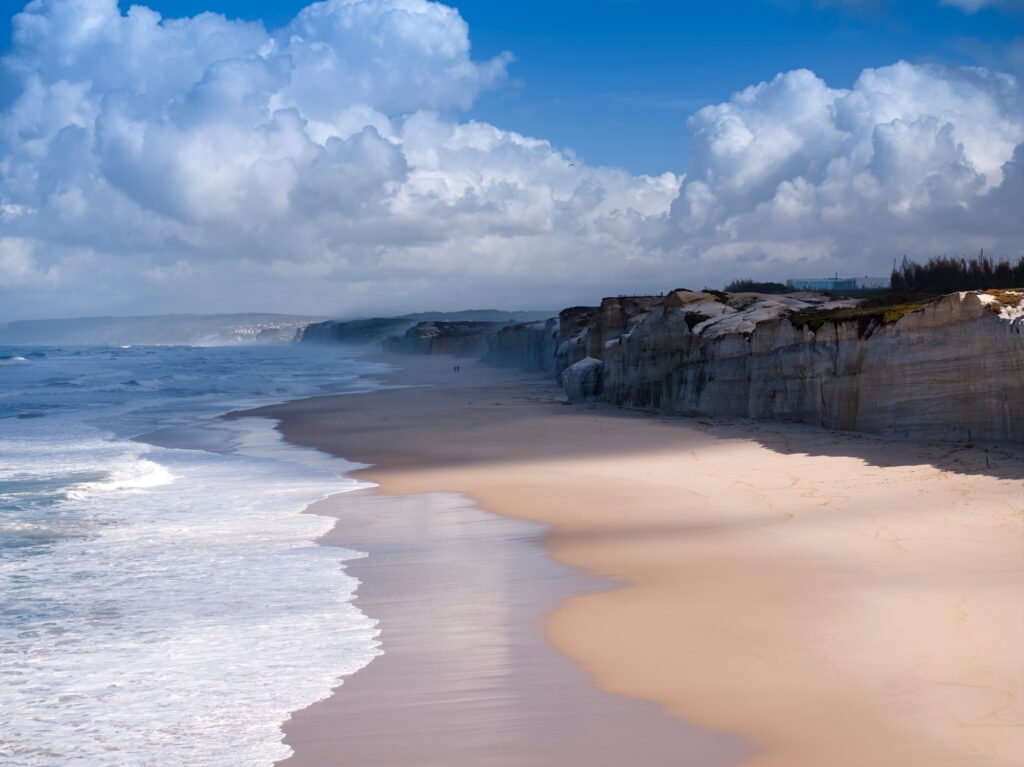
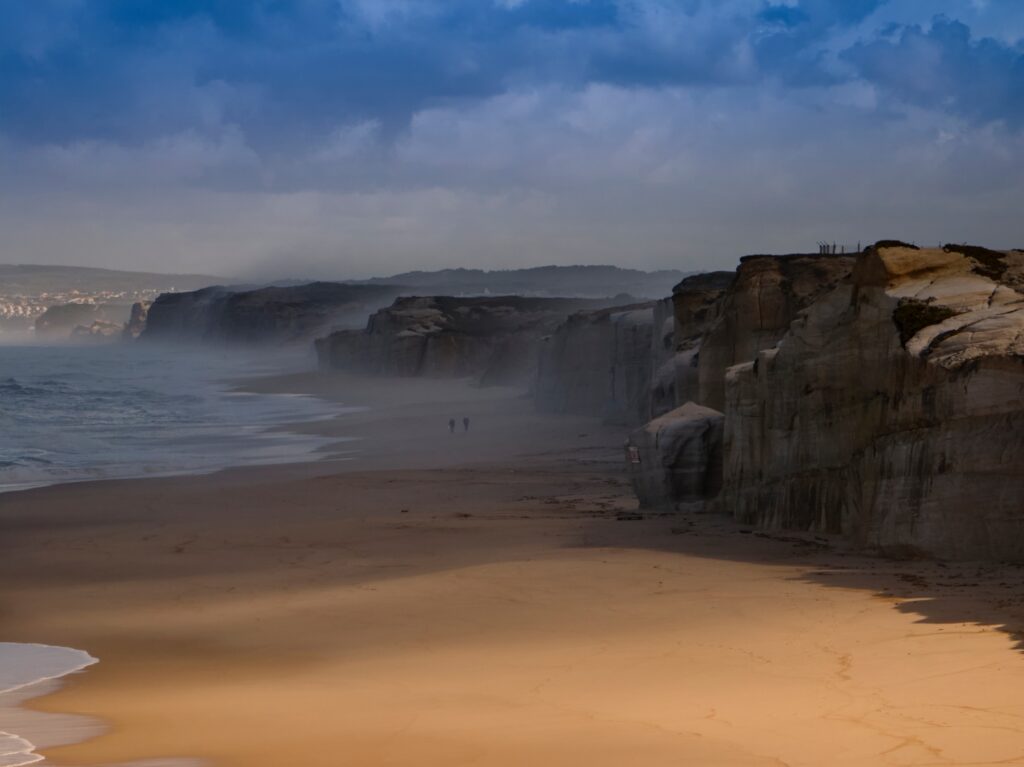



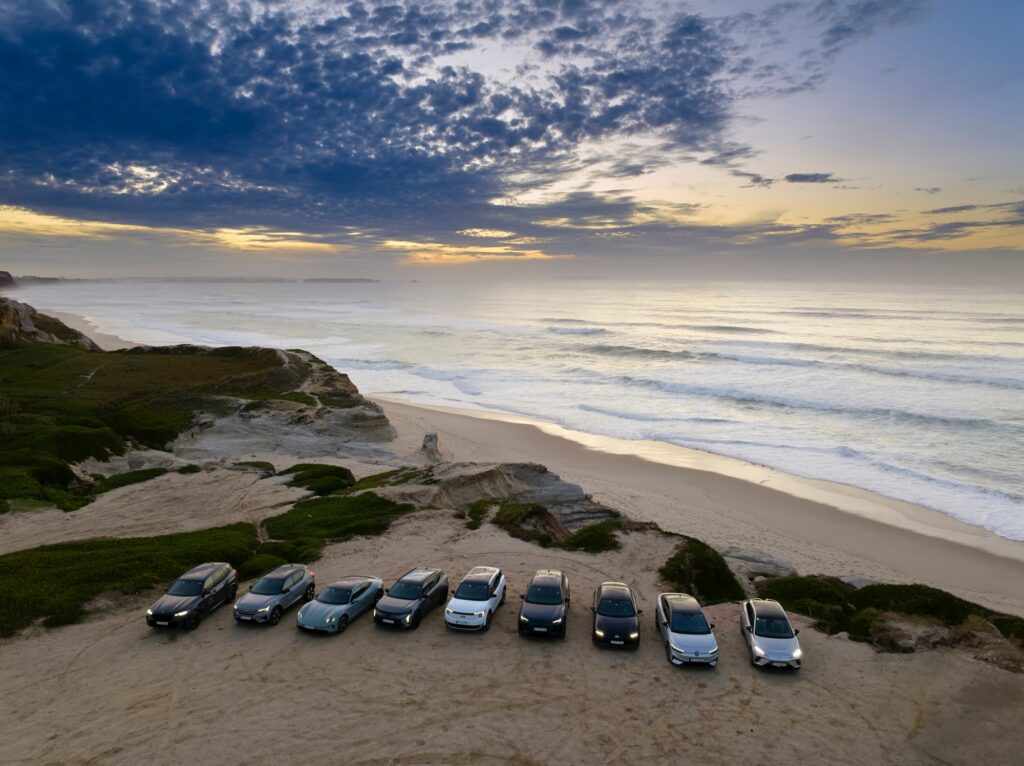
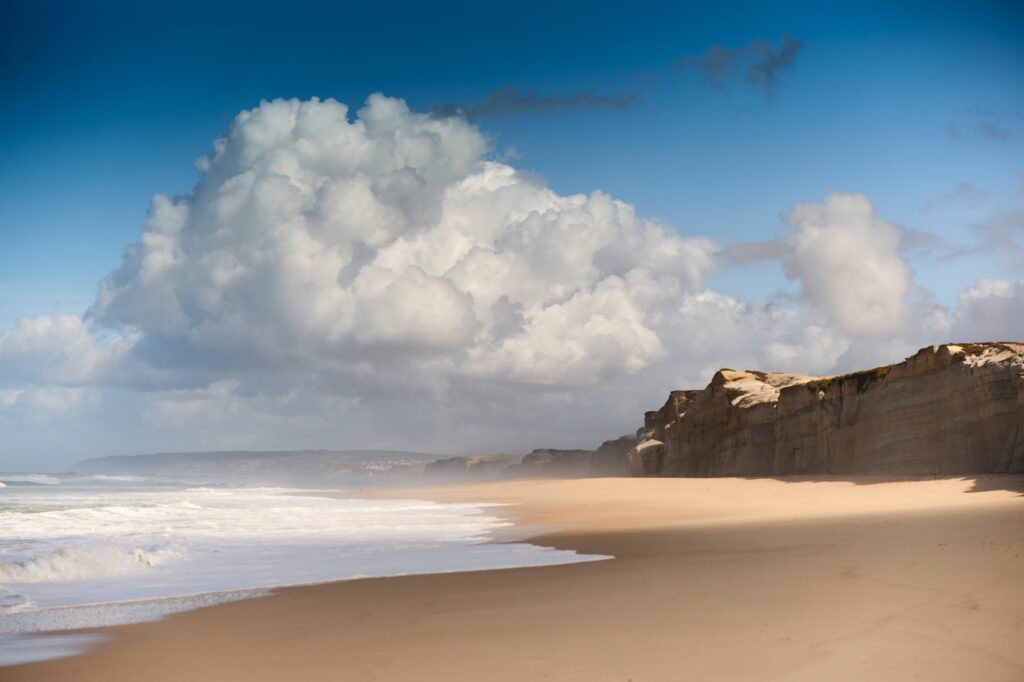
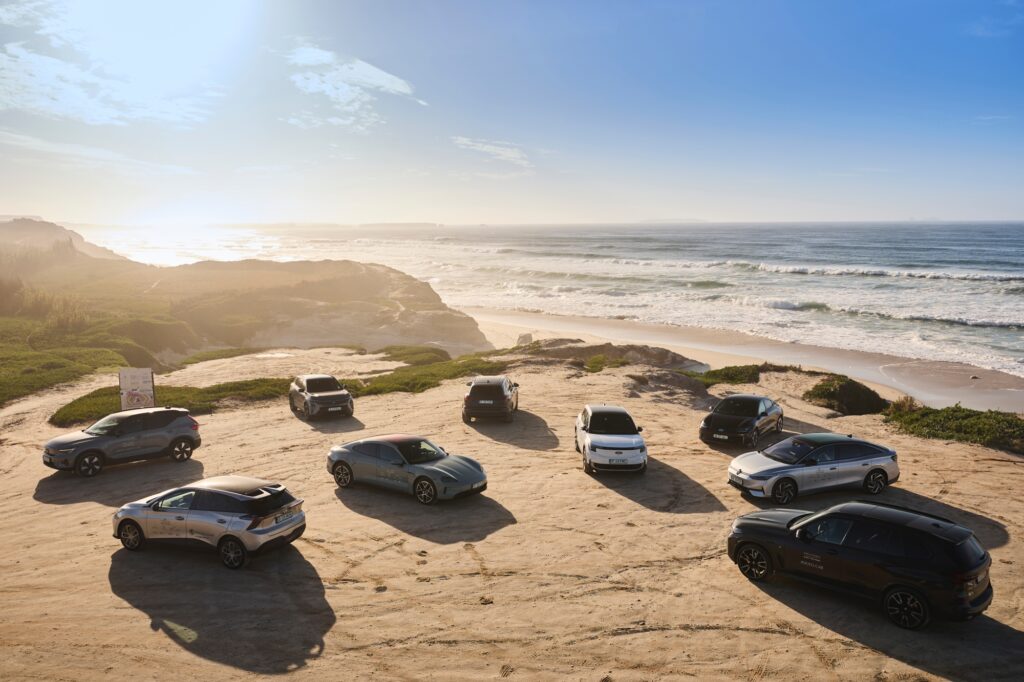
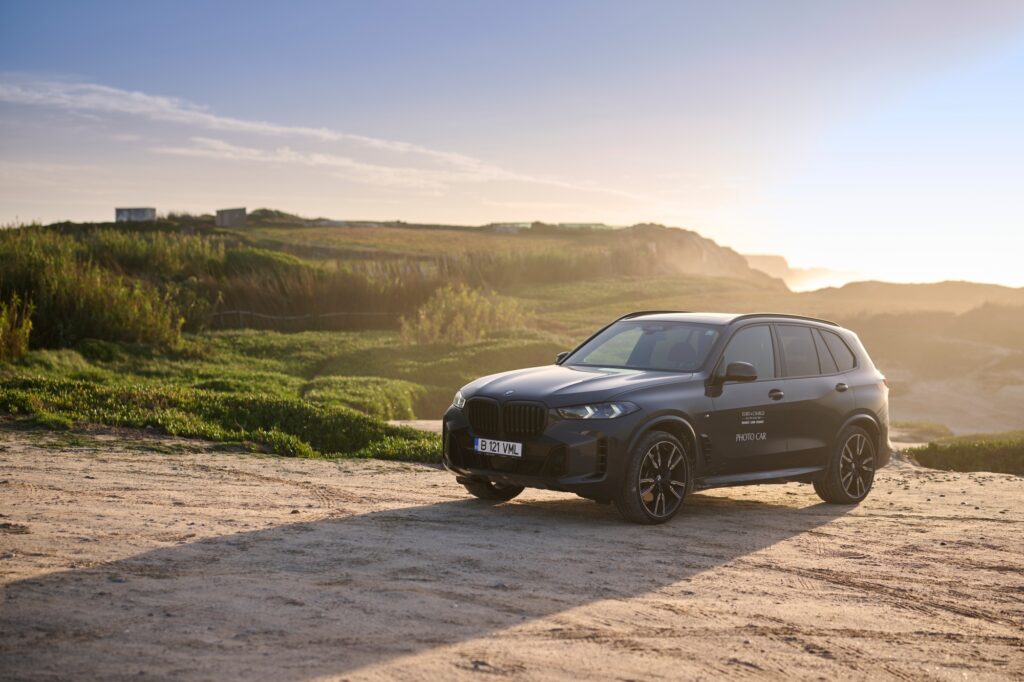

A narrow bridge over an even narrower river, followed by a road narrow enough to fit a car, an asphalt ribbon described by stone fences left and right. And ID.7’s stop signs, photographed and filmed on hills guarded by cork oaks, the sentinels illuminated by the last flicker of sunlight.
And then darkness. Some regret shaking hands with Portugal in the dark. Hotel in the middle of the night. In the morning. And a compressed segment finale on a day off, with the best Lusitania has to offer: sun, beach, waves, sunset.
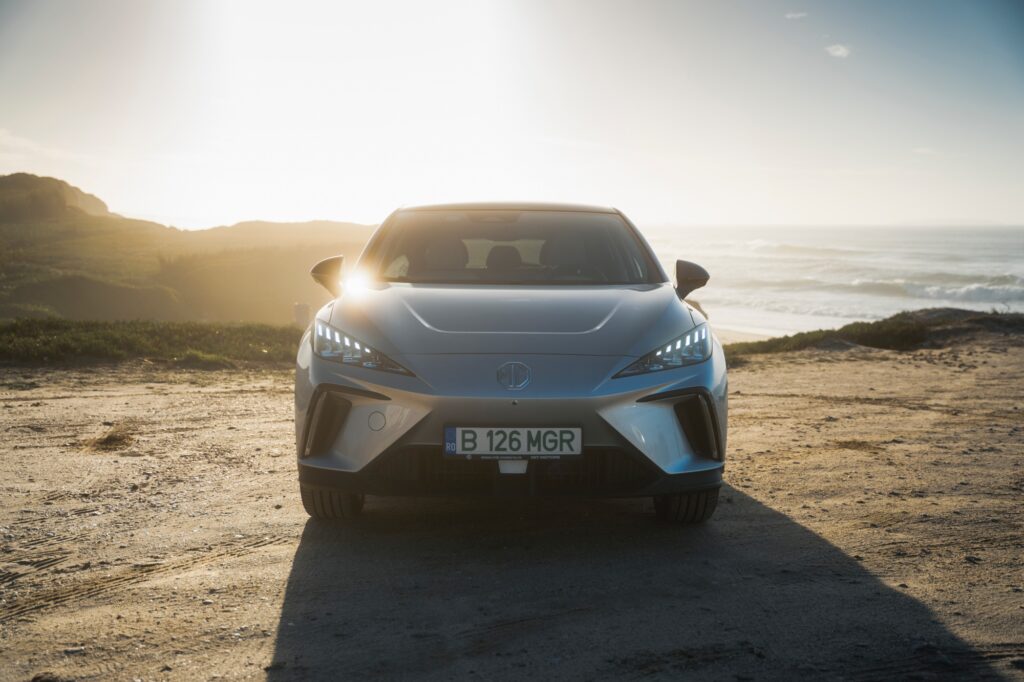
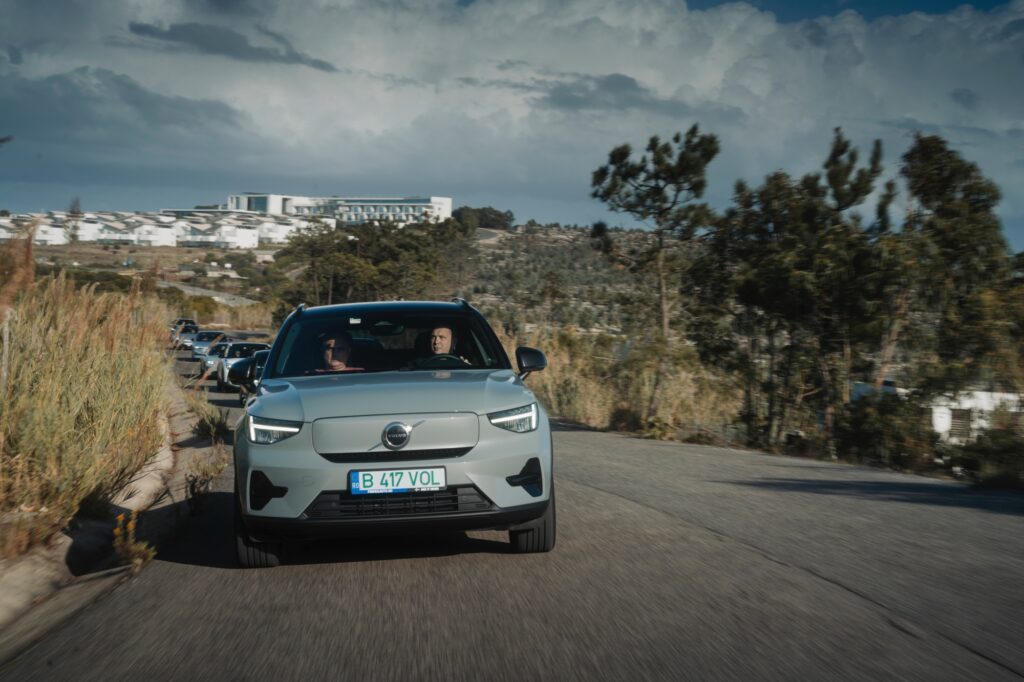
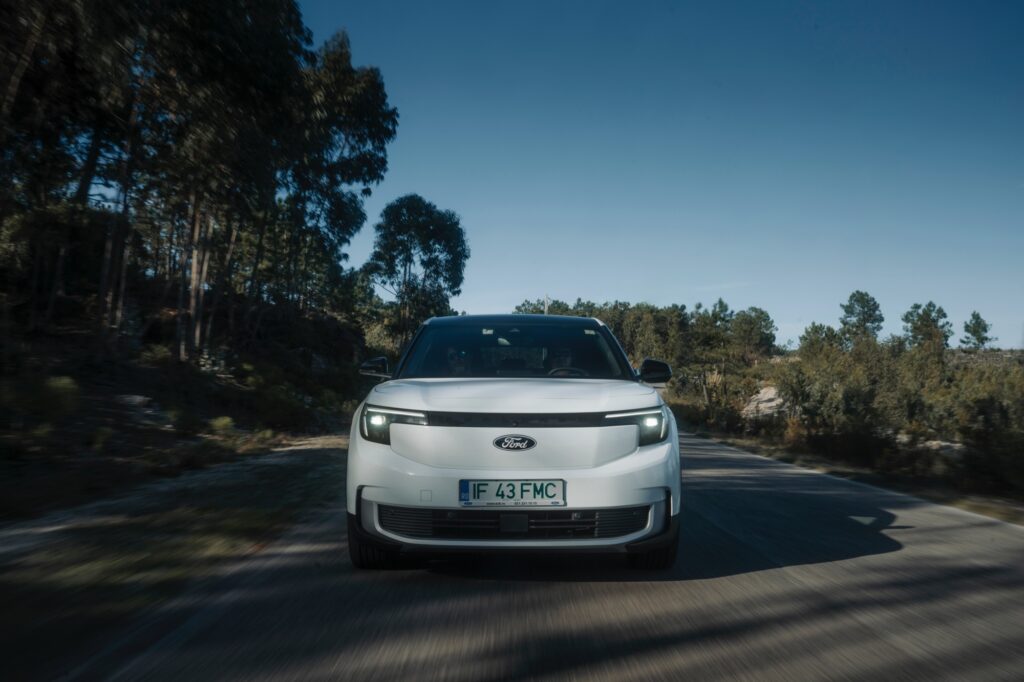
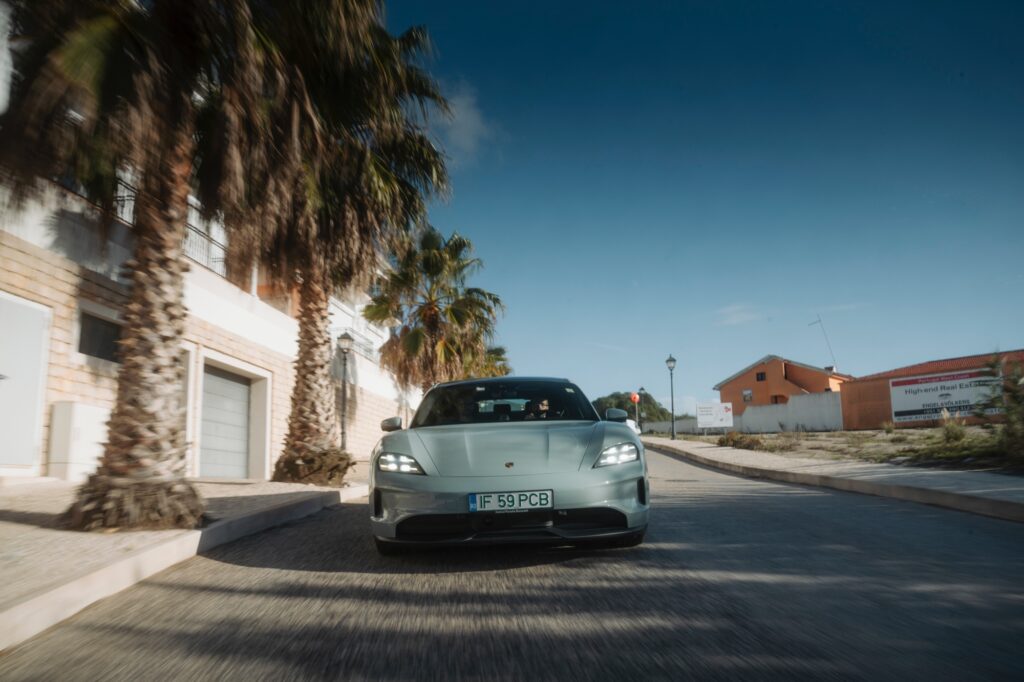
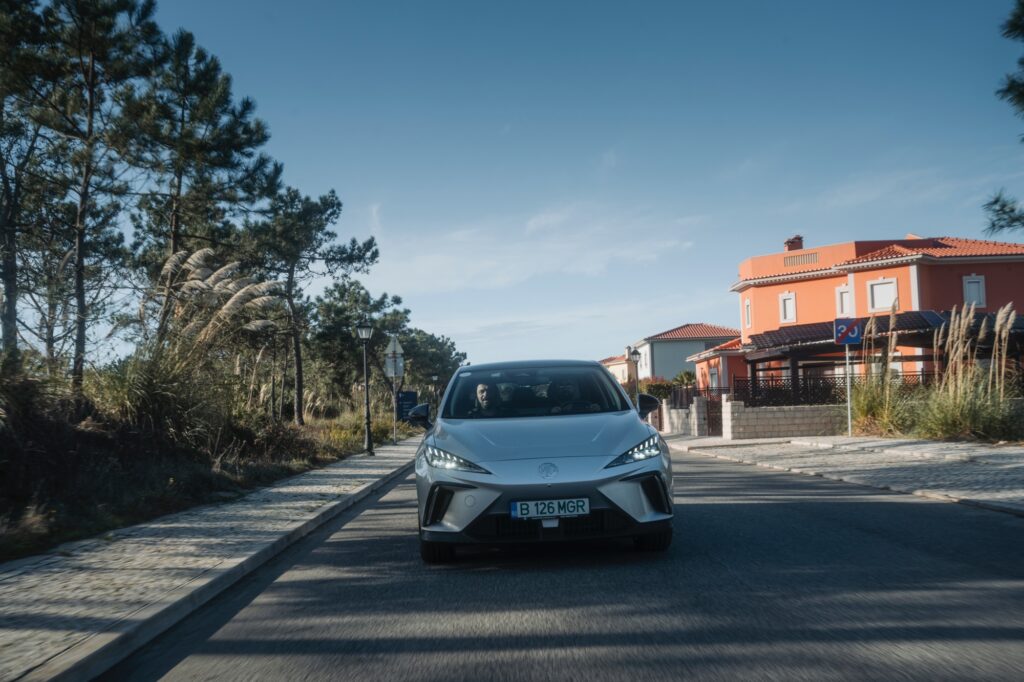
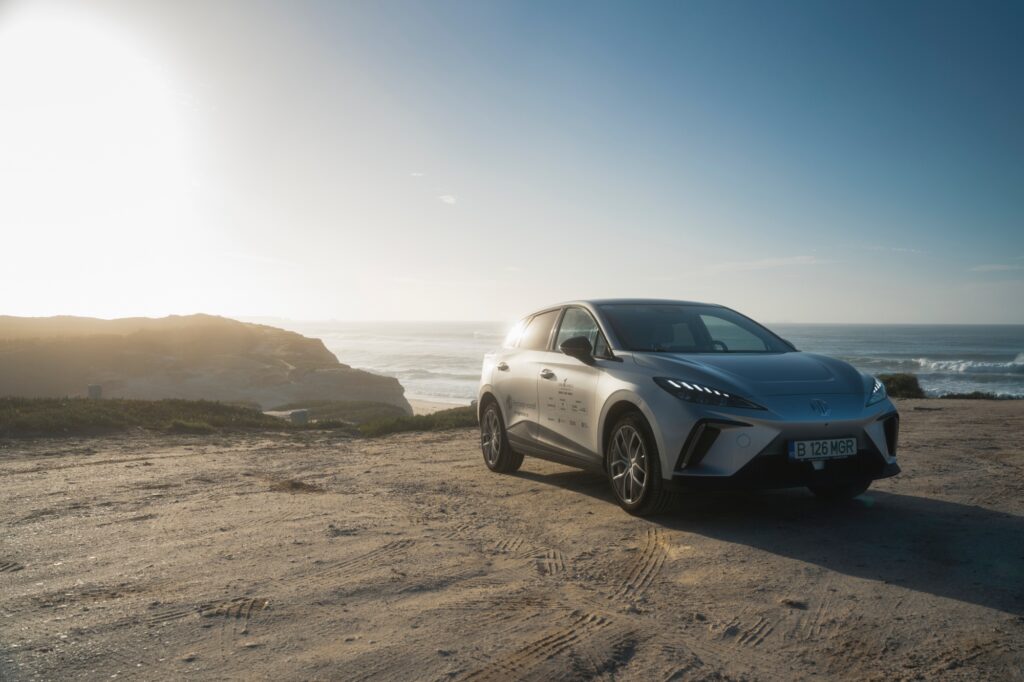
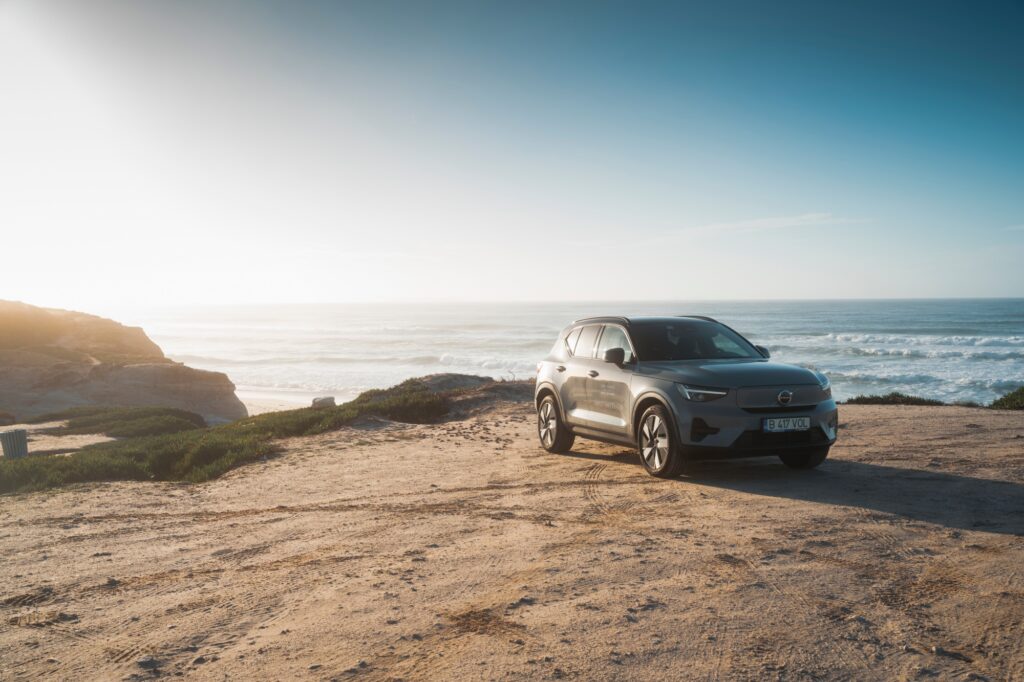
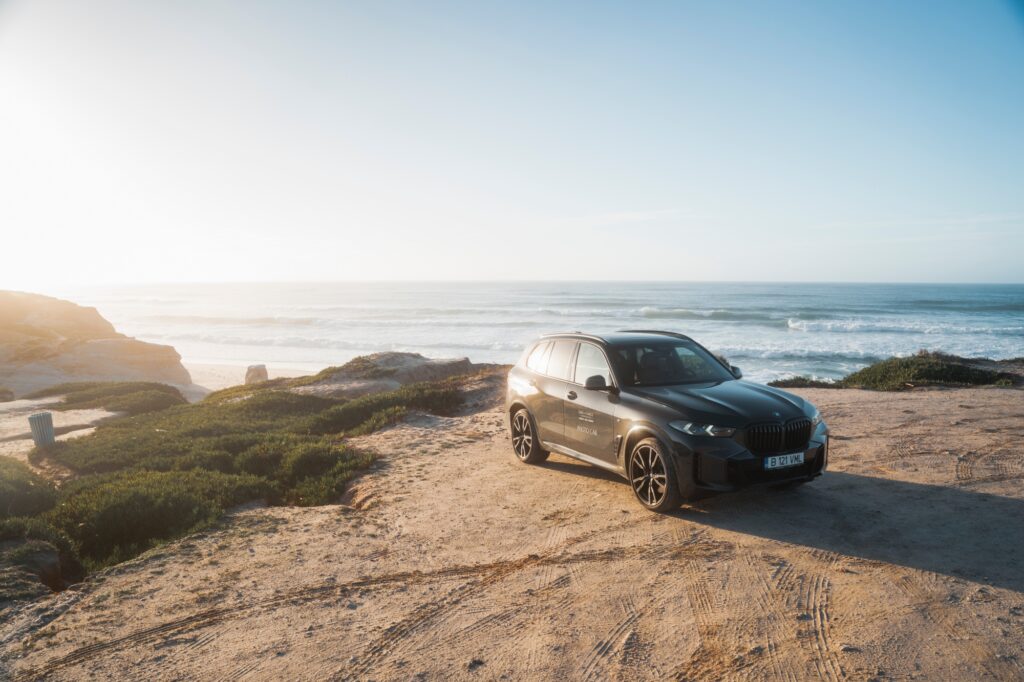
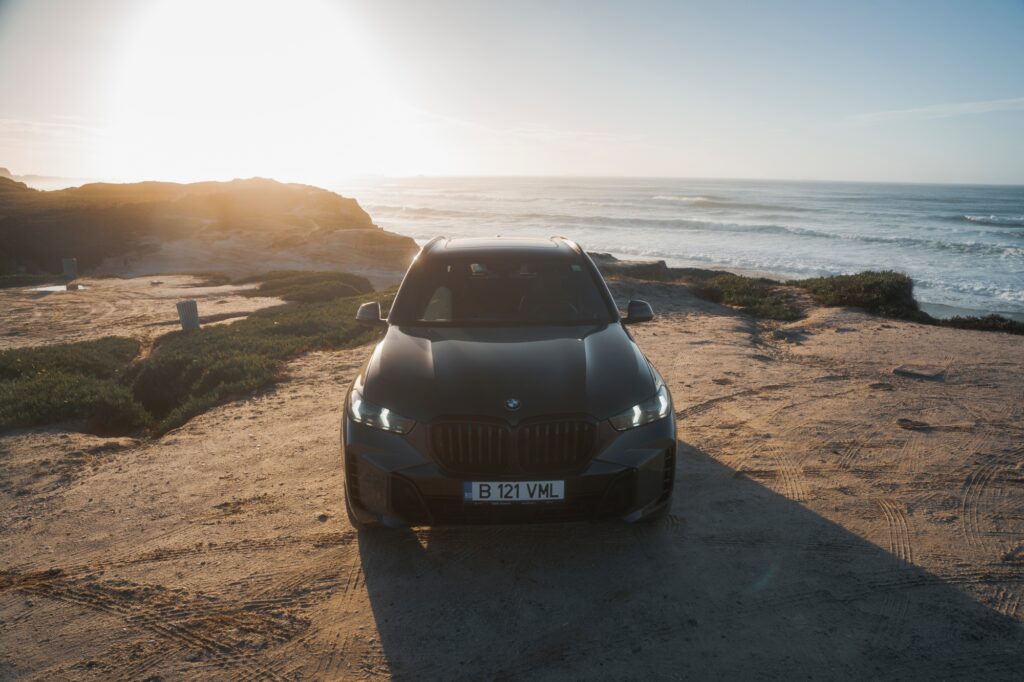
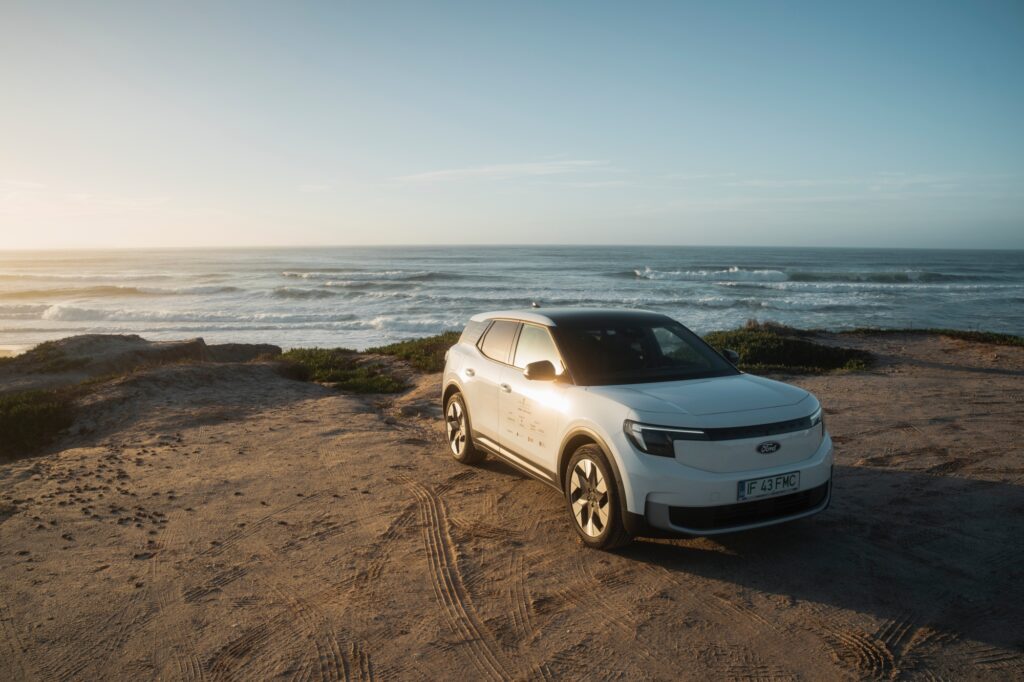

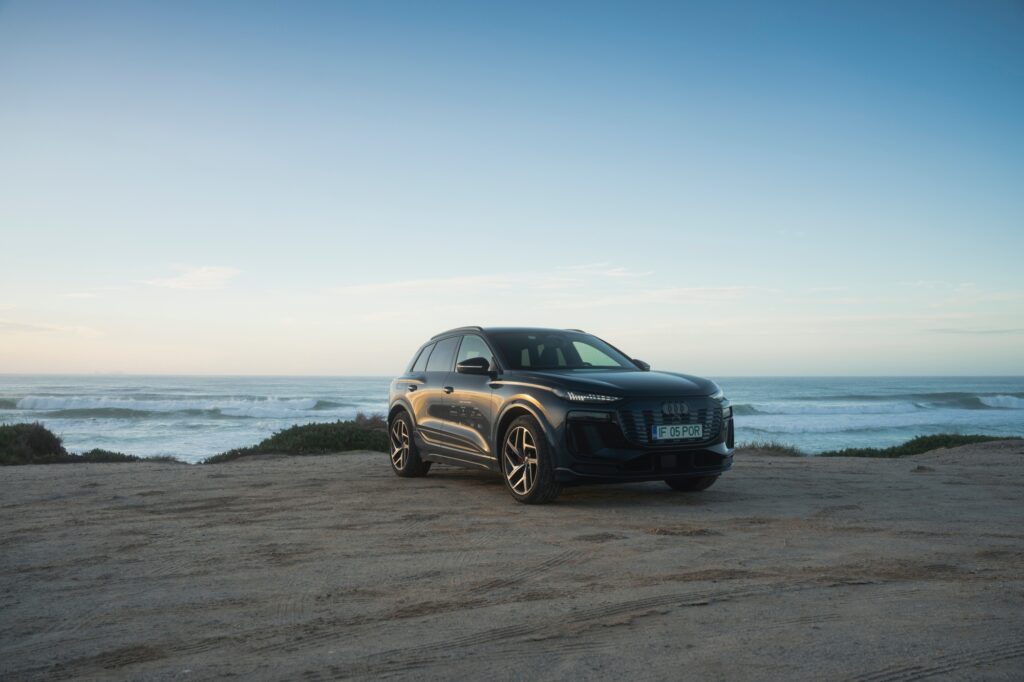
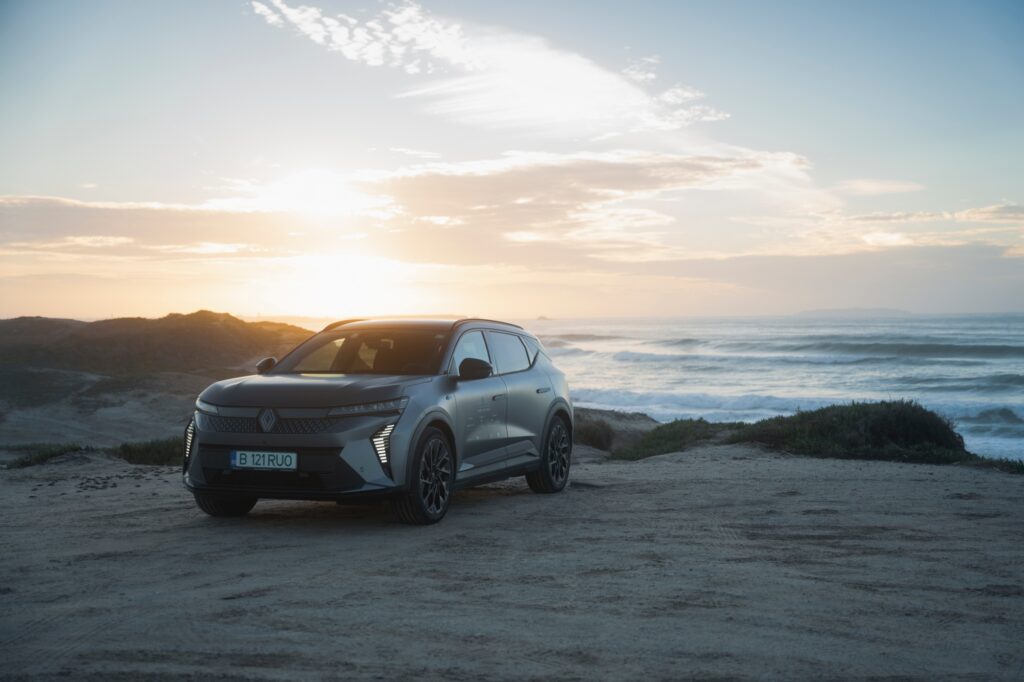
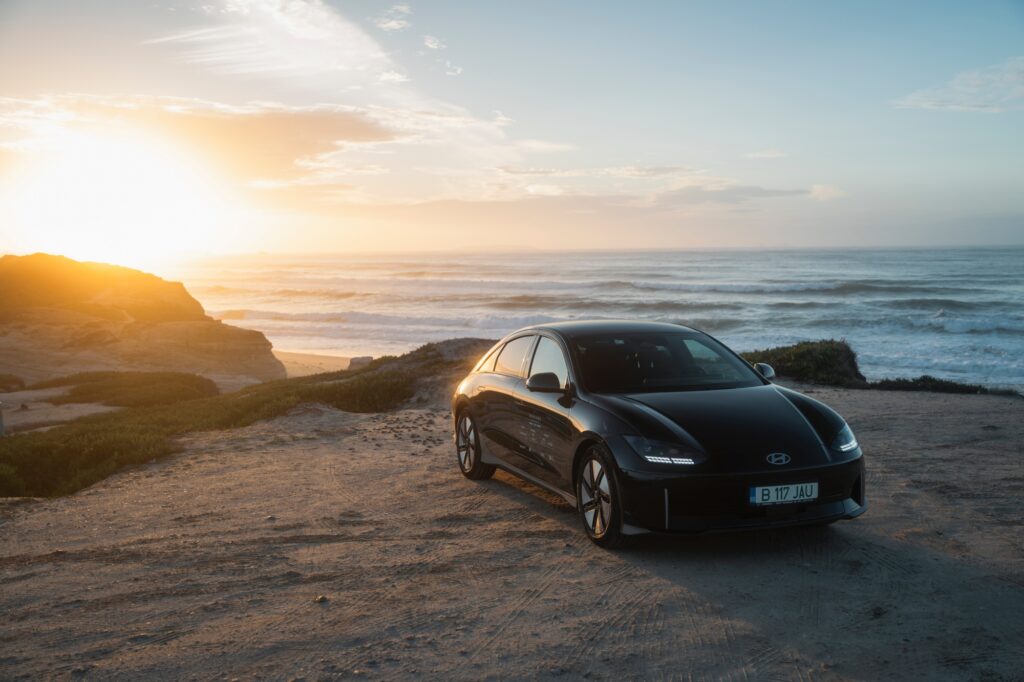
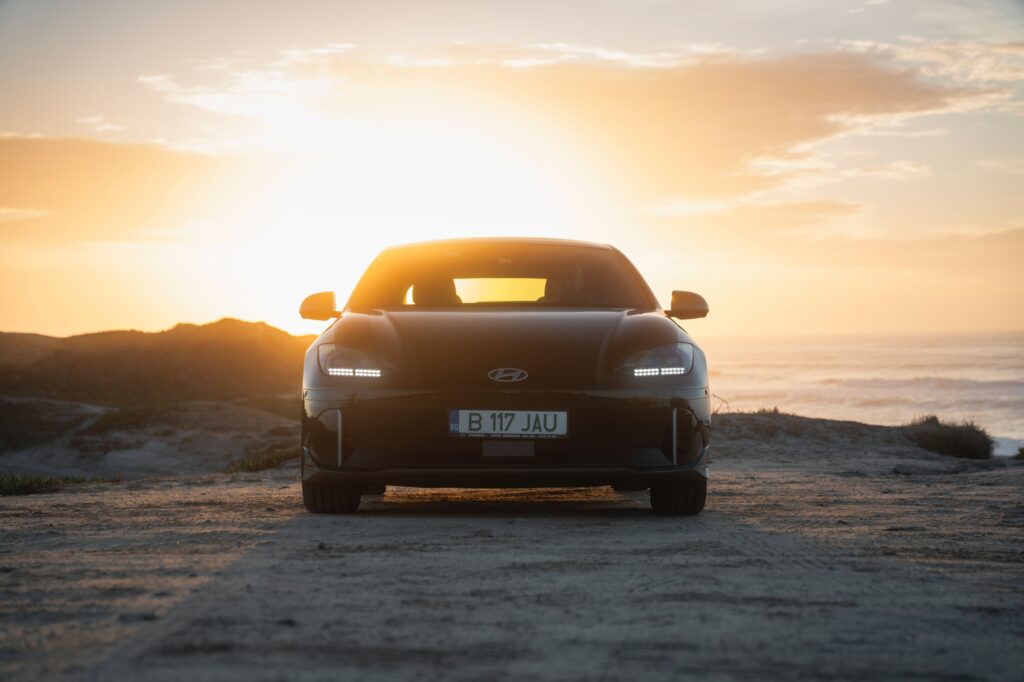
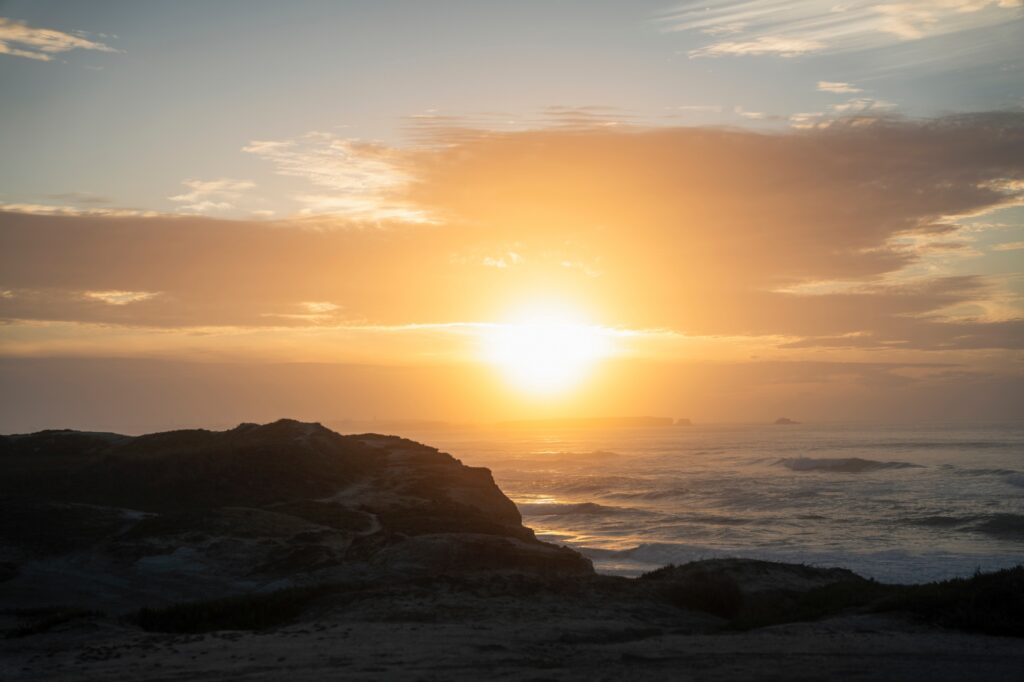
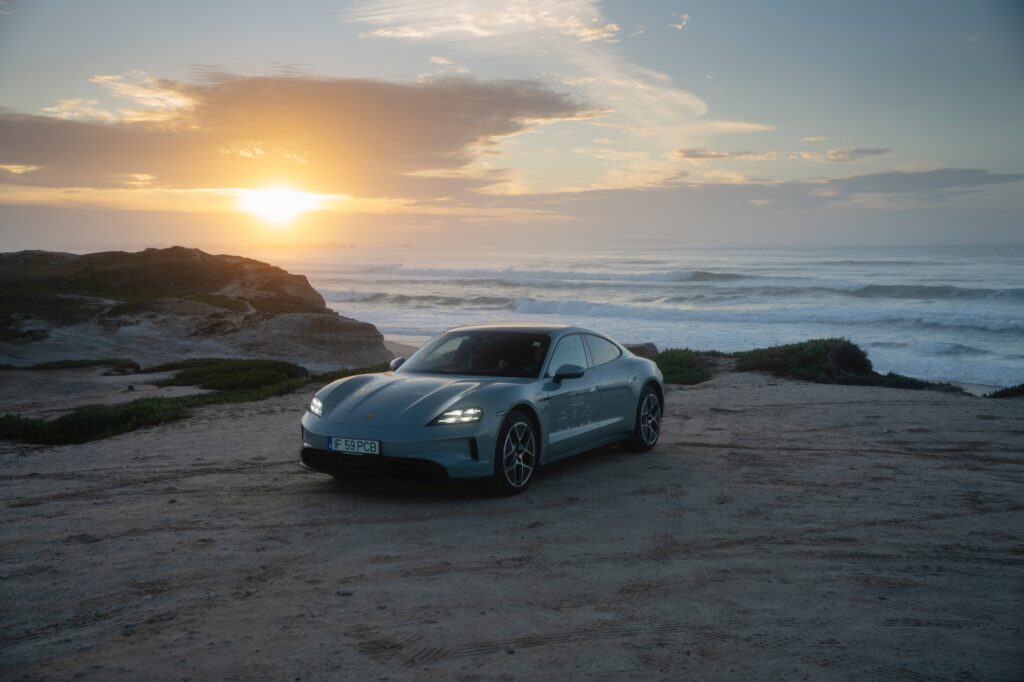
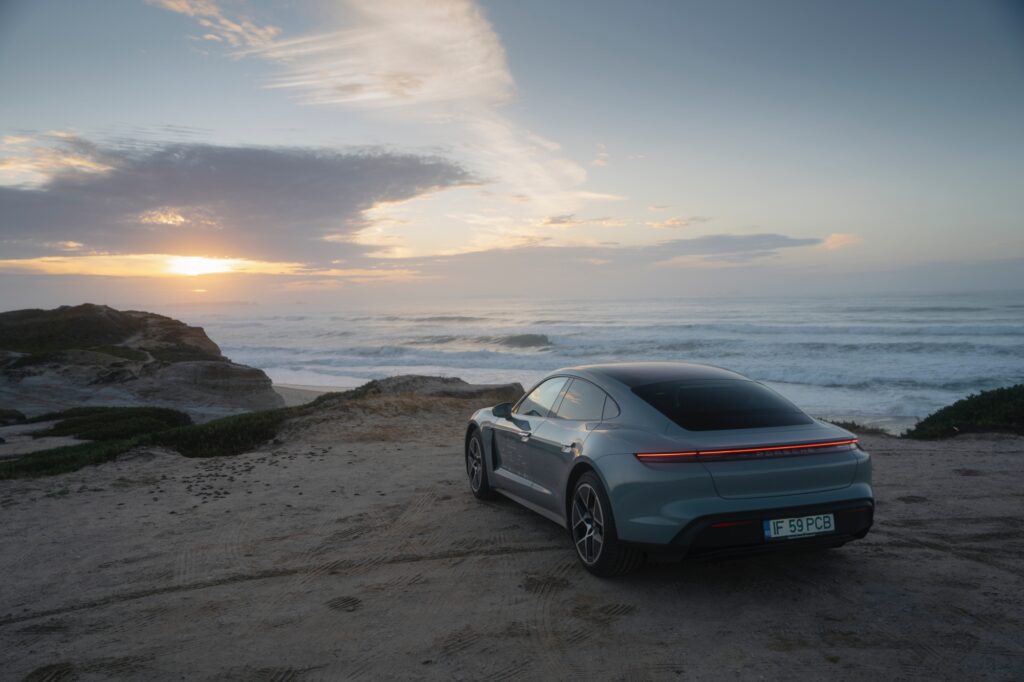
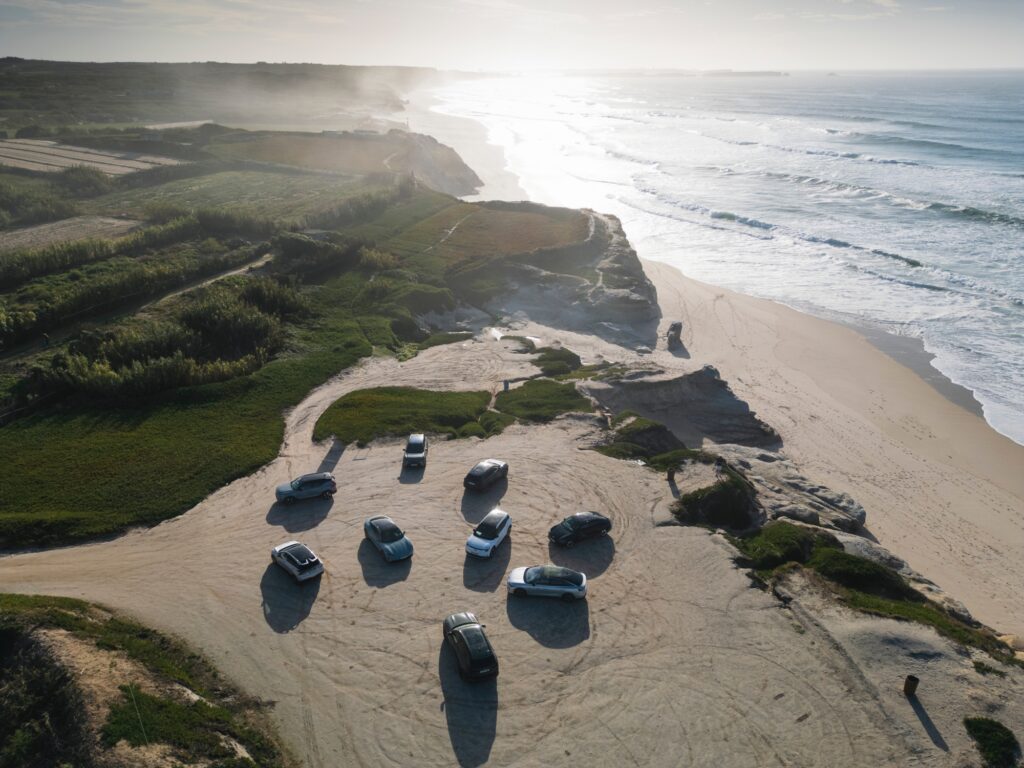
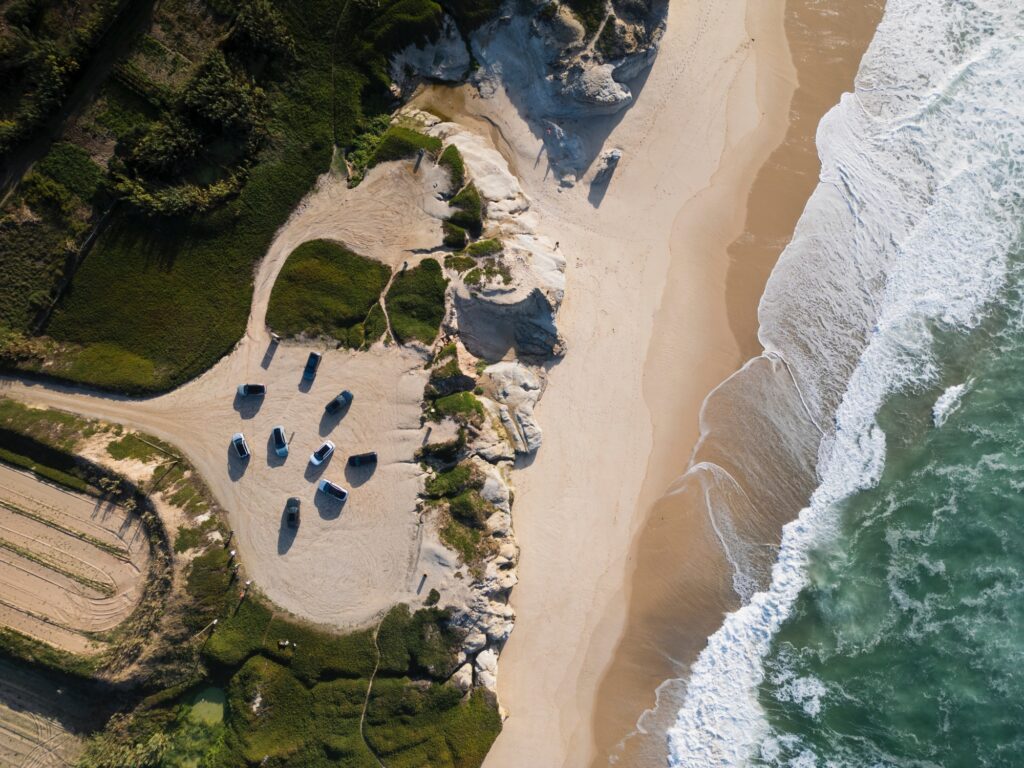

Here we are.
We breathe in the exhaled ocean air and head back to Bucharest. With eight electric cars.
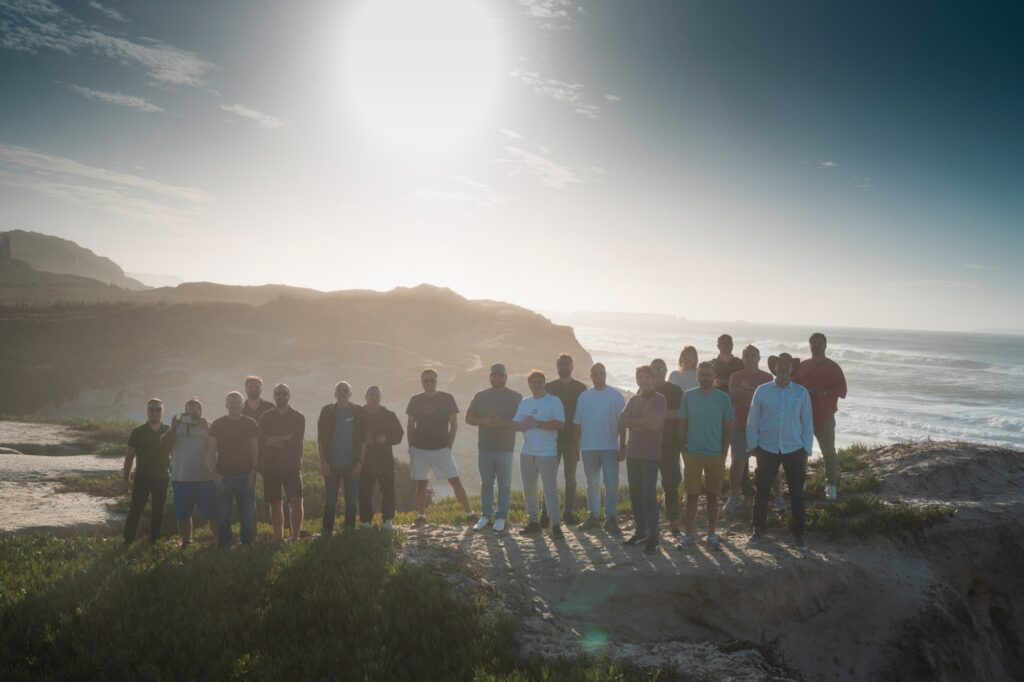
Adrian Mitrea(0-100.ro) about Audi Q6 e-tron
It’s hard to pick what impressed me most about the Audi Q6 e-tron quattro, so I’m picking several. And a few minuses.
The car has charged exemplary in all the 1,000+ miles I’ve spent in it. Often powers over 250 kW and 10-80% in 20-25 minutes. Range? Always around 400 km in rough conditions: rain and strong headwind. Wind so strong it knocked over a trash bin right next to the car at a charging station in Spain.
The LED matrix headlights and suspension are state of the art, as on any Audi in the 100,000 Euro range. I felt comfortable on board, all the way. A car in which almost nothing bothered me can be the definition of a good car. This is the Q6.
But yes, there are minuses: the icons on the multimedia system are too small, and some are obscured by the steering wheel. Also the charging port covers, they smell like a nerve source. So the latter I’d avoid in the car setup (can do without them).
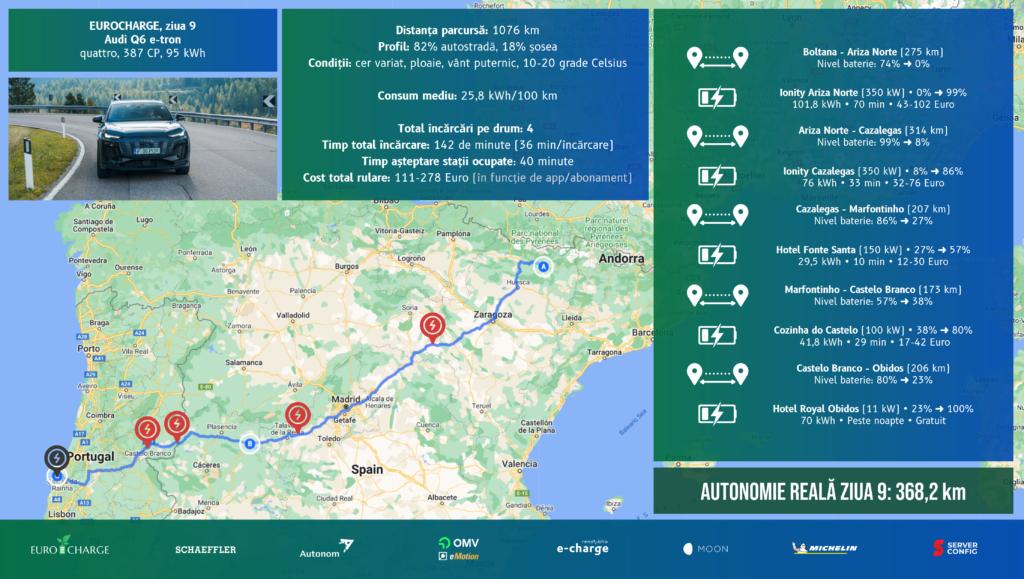
Mihai Vasilescu(mihaivasilescu.ro) on Ford Explorer
Ever since I first saw the list of cars we’ll be driving in EUROCHARGE, I’ve wanted to drive the Ford Explorer, because I was looking for it on the street, it looks like a very nice car. 1,100 kilometers later, I can say that I got my wish in spades.
One of the things we should all do is to recognize when we’re not good at something (or when it doesn’t turn out the way we’d like it to) and ask for help from others who have proven to be better at it.
In my layman’s mind, that’s how I translate the collaboration between the two giants, Volkswagen and Ford, which resulted in the Ford Explorer model, exclusively for the European market. In short, Ford needed an electric model to meet the demands of this market, so they turned to Volkswagen for the job. The result is the Explorer, which is built on the Volkswagen ID.4 platform.
What’s the result? A compact SUV that as well as being a cool-looking car, it’s also a pretty capable electric that can do everything an ID.4 can do. It has a single engine, on the rear axle, that produces 286 horsepower, which makes it pretty svelte.
But it’s not that that impressed me the most, it’s the way he knows how to recover energy and get the most out of the 77 kWh battery. He does it as well and with as much ease as his German cousin from whom he took over the platform.
Did he also crack me up with the huge center screen that slides out and the glass roof that lets a lot of light inside? OK, it doesn’t feel like a convertible, but it’s still cool. And you really appreciate that slide-out screen when you realize that when you slide it out, there’s a storage space underneath it where you can put some of the many other crap you carry around. Phone, wallet, keys and other things you don’t usually know where to keep in your car.
The only thing that I grimaced at was the soundproofing. At times, at high speeds, I thought there was a bit too much noise in the cabin. But, to be perfectly honest, I don’t know if it’s the fault of the Explorer or the fact that I drove it on one of the days with a weather warning of thunderstorms and high winds. There were times when the wind was blowing so hard it pushed me off the road. I figure there’s no way you couldn’t hear the blizzard from the car, which is why I say maybe it’s not her fault. If I ever get to drive it on a highway again, I’ll figure it out quick.

Constantin Ciobanu (AUTOCRITICA, Adevărul Auto) on Hyundai Ioniq 6
What can I say, a privilege to have the model on a +1,000 km stage. If this tour has taught us anything, it’s that an 800V platform is what you need if you want an electric vehicle for long-distance travel. When you’re pulling from 200+ kW stations, charging times are a joke.
Even if looking from the back, and I have looked at this model from the back for some time when I was driving other models in EUROCHARGE, it reminds you of a 930 Turbo, I appreciate the courage to propose a bolder design. The same bravery vis a vis the layout I found in the interior, and I appreciate the freedom to design differently as long as you don’t want to reinvent me as a user/driver.
The Ioniq 6 also wins when it comes to interior space, something bordering on opulence. I would have liked some of the exuberance to have been matched with more carefully chosen materials. The big gripe is the seats. They’re not what you need for long journeys, although that’s one of the car’s strengths. After 200 km, my body was already complaining about one thing after another. It’s the only element that contrasts strongly with the rest of the car, because the soundproofing and suspension settings are also good.
The conditions in which we drove the Ioniq 6 were among the harshest we have ever encountered. The periphery of a hurricane caressed us half the way with headwinds around 30mph and gusts to 90mph. This showed in the consumption, but nevertheless we felt no threat of running out of kW.
The design pays a small tribute when it comes to ergonomics, and here I’m talking about the trunk opening, which is a bit narrow in the cargo slot.
But I can say that the Ioniq 6 is one of the most mature electrics yet.
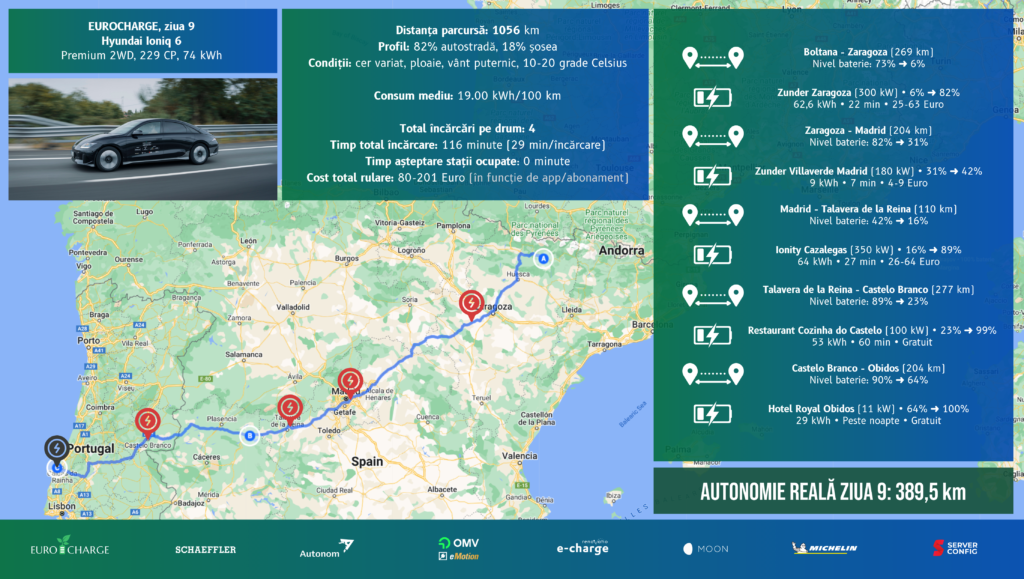
Dan Scarlat (TopGear Romania) on MG4
The MG4 is the most compact (under 4.3 m long) and lightest (1,751 kg) car on our tour, making it also the most recommendable for the average urban customer, as it is the easiest to park/maneuver through the crowds often found in big cities.
What’s more, the present 245bhp rear-wheel drive version (or ‘rear-wheel drive’, if you’re not fussy with the wording) has hot hatch acceleration and very dynamic handling, which makes it great fun to drive on twisty back roads.
The bodywork has a monovolumic look, which helps the interior space on offer. The overall design is quite simple, but the car makes up for it with interesting details such as the sharp headlamps or the sharply contoured rear end with bright zigzags above the light clusters and a two-segment roof spoiler.
Disadvantages include a top load speed of 140 kW, one of the lowest in the group (along with the Ford Explorer), relatively high fuel consumption at highway speeds (which also affects the range in this type of mode), and above all the infotainment system, which requires some getting used to and does not react very promptly to the operator’s commands. Also, for some reason that escapes me, the Chinese equate a temperature of 22 degrees Celsius, which is normal for us Europeans in a car, with a value of around 26 degrees Celsius on the climate control display.
On the other hand, the MG4 is, even in this well-equipped version, the cheapest car on the tour. The €41,000-plus price of the Exclusive Long Range version is €10,000 more than the base model called Explore, equipped with a 177 hp engine and 51 kWh gross battery, which is one of the most affordable compact electric cars in Romania.
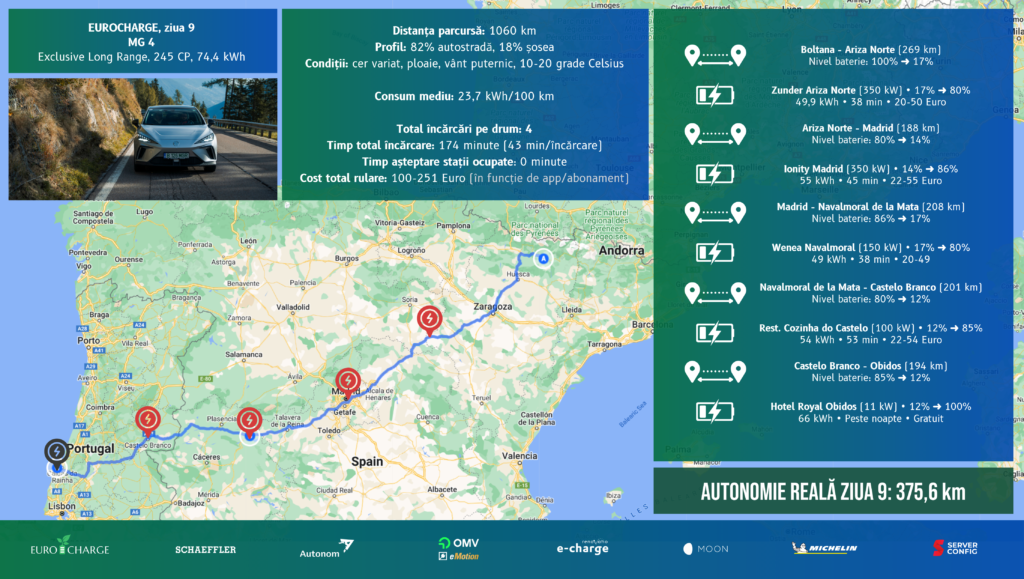
Andrei Barbu (MotorVlog TV) on the Porsche Taycan
When you can do a whopping 1,106 kilometers with charging breaks of just 33 minutes*, life with an electric car is… different. When you have the Taycan.
Because the car flies down the highway with ease, only to charge almost brutally fast. How fast? Well, about 80 kWh in 21 minutes. Considering the charging power was limited by the station, not the car. So it could have been better. But that’s only a small part of the story.
That’s because the Taycan looks like a Porsche, drives like one, and when you’re cornering, it kind of makes you forget about gas. It’s instantly responsive, in every situation, agile and quick, as if the several hundred pounds of battery pack are basking in weightlessness. And on top of that, when you’re going smooth, steady and linear, it’s comfortable and refined.
It’s hard to recommend an electric car other than the Taycan. The only problem would be the price. But since money is no object, we can always dream.
*plus a charge at dinner, but that doesn’t add up to the amount of minutes lost
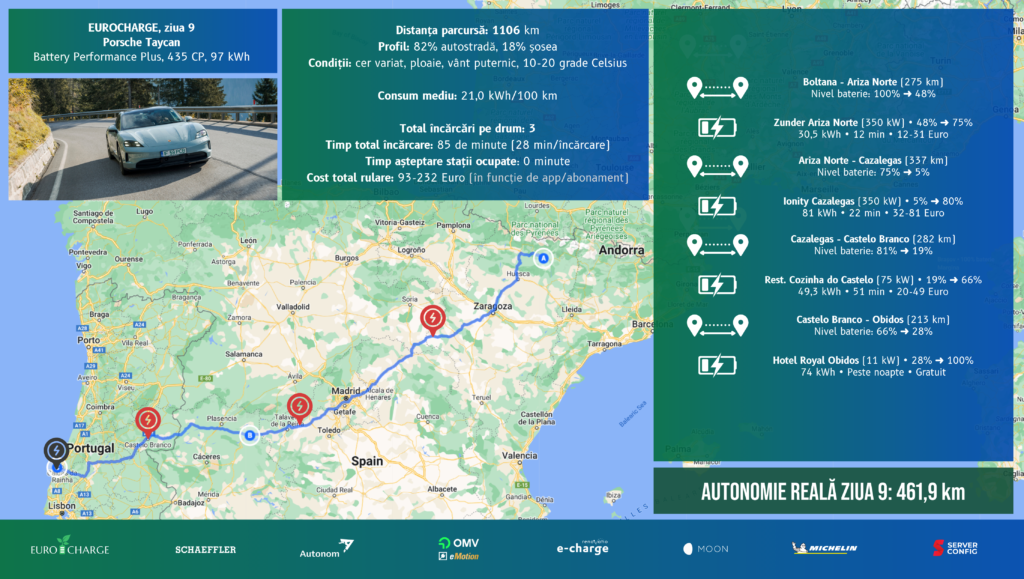
Tibi Buzdugan(electromobilitate.com) on Renault Scenic
Two years ago, I had the opportunity to drive a few hundred kilometers in the Renault Megane E-Tech at ROCHARGE 2022. It was the biggest surprise of the eight electric cars tested then. We discovered that many features you’d expect to find on premium cars costing more than 80-100 thousand euros can also appear on a more budget-friendly car. The Renault Scenic continues this trend, in a slightly bulkier form.
It is a perfect family car, offering plenty of space both inside and in the trunk (over 540 liters). The sustainable materials used in the interior are nice, and the seats are very comfortable on long journeys (after over 1,000 km behind the wheel, I felt as rested as after a two-hour drive). I particularly liked the way the adaptive autopilot worked, which never jerks the car and made driving very smooth. Under the two digital screens – the one behind the steering wheel and the one in the center – is Android Automotive.
To me, it remains a mystery how so many car brands continue to develop infotainment systems in-house, even though they are far inferior in every way (ergonomics, response times, functionalities) compared to existing solutions, instead of adopting a system that actually works as expected in 2024. But examples of deficient ego and management are in every industry, so it couldn’t miss automotive.
One clear example is navigation: you have Google Maps integrated, select your destination and automatically see the estimated battery percentage on arrival (which takes into account differences in altitude on the route and weather conditions), whether you need to charge en route and how long to stay at each stop to optimize travel time, and so on.
On the day we reached the ocean, starting from the Pyrenees, we drove almost 700-800 km with a very strong headwind, which increased consumption by 20-30% compared to the previous days, even though the highway speed limit was 120 km/h. However, on each 200-300 km stretch of road, the estimation of the percentage of battery at destination made by the car’s navigation system was accurate to 1-2%.
At this price point, I find it difficult to find a better car in terms of space, interior features and materials, whether it’s internal combustion or not. It’s not for nothing that it won the 2024 European Car of the Year award.
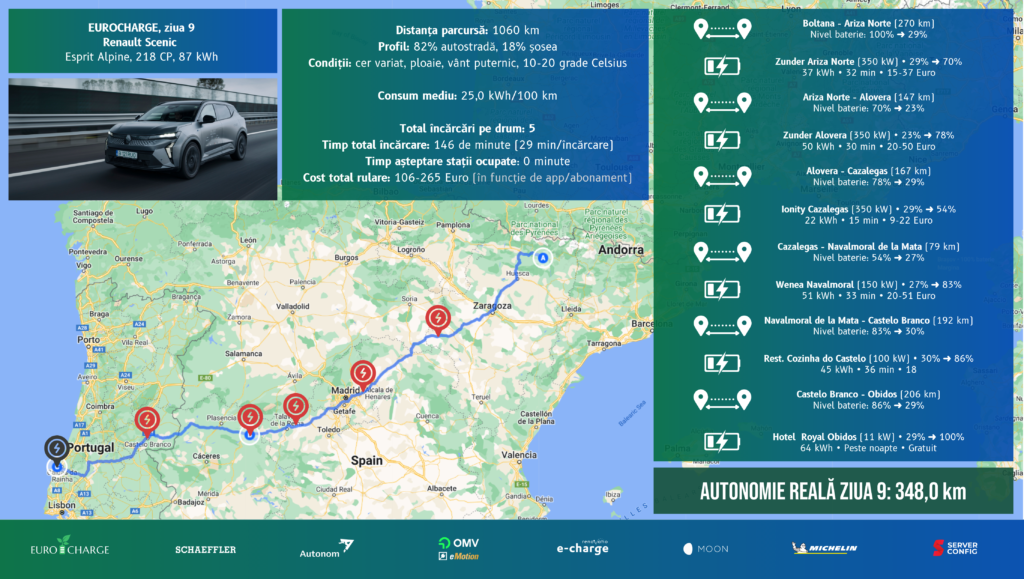
Bogdan Grigorescu (AutoExpert) about Volkswagen ID.7
Hello! Allow me to report: we just found out what ultimate comfort feels like. The Volkswagen ID.7 is by far the most comfortable car you can buy for up to €65,000. First and foremost, thanks to the adaptive suspension that impeccably filters out bumps when in its most comfortable setting.
Then there’s the huge space in the back. Finally, the comfortable ErgoActive shoulder and ergoActive seats with integrated massage make the whole journey the ultimate experience. “Sure, until the battery runs out,” you might be tempted to say. I beg to contradict you, because vacations also last longer when plugged in. The ID.7 charges extremely quickly, with up to 190 kW, but not just on paper, in real life too, and the actual range has always been between 400 and 500 km, because it’s extremely aerodynamic with a Cx of 0.23. Needless to say, interior noise is also minimal, with almost no air turbulence.
Just milk and honey? Not exactly. I would have liked physical buttons on the dashboard and steering wheel so I wasn’t always fumbling around when looking for convenience functions or setting the autopilot, and I would have liked the wipers to be controlled from the right side of the steering wheel rather than the left, on the turn signal lever. Clearly, it takes some getting used to fully befriend the German. But I warn you: habituation is addictive, comfort is addictive, and you won’t find a relaxing car like the ID.7 in this price range!
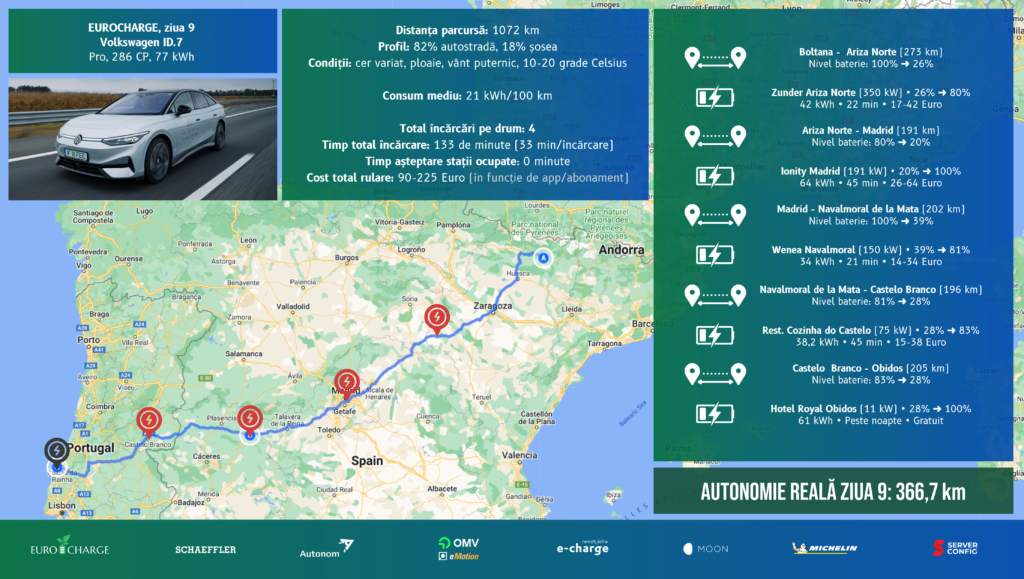
Berti Panaiot (AUTOCRITICA, urbanadventures.ro) on Volvo EX40
4439. No, it’s not the pin on my credit card, it’s the number of kilometers I traveled from Bucharest to Portugal, in Peniche, somewhere on the Atlantic coast, in the Volvo EX40.
It’s been an “electric” couple of days so it’s time to take stock. We are halfway, we have crossed Romania, Hungary, Austria, Italy, France, Spain and Portugal, and of course there is still the way back.
But I think that there are already enough kilometers and experiences for a first assessment in Eurocharge by Schaeffler.
So, let’s start with the range, because this is the topic that I’m sure everyone is interested in. In ideal conditions, the car could travel between 520 and 576 kilometers (WLTP), but then again, in ideal conditions I’d still have my little house by the sea on an island in Greece.
The car’s range is influenced by the type of road, ambient temperature and, we have now found out, wind. One day, for example, I had a range of 479 kilometers on the roads between Austria and Italy. It was a 430-kilometer drive, only one third of which was on the highway, in partly rainy weather with temperatures of up to 10 degrees Celsius. That is much closer to the official figures than I am to the little box in Greece.
But we also had a day with a range of 345 kilometers, when the wind messed us up a bit and was gusting almost as fast as our highway speed limit.
Now let’s move on to our time at the charging stations. But first let me tell you what I’ve learned now. The recommendation is never to charge above 80% on a long road trip because you’re unnecessarily prolonging your time at the station, and in these conditions I spent between 15 and 30 minutes, depending on how much energy I ended up with in the battery. The car pulls up to 205 kW, so I only chose fast stations above 150 kW. That’s just enough for a refreshing pit stop on the highway.
I loved it the most that all the stations were in gas stations and I could sit and have a coffee and, the coolest thing, I never had to wait for another car to charge either when I arrived in a place with only two stations, for example, or when I arrived in hubs with more than 10 stations. Just in case you were worried that there was no viable infrastructure for electric cars on Europe’s roads.
All in all, the 4439 km in the Volvo EX40 were as zen as a dinner in the Nordic countryside enjoying a glogg by the warmth of a campfire.
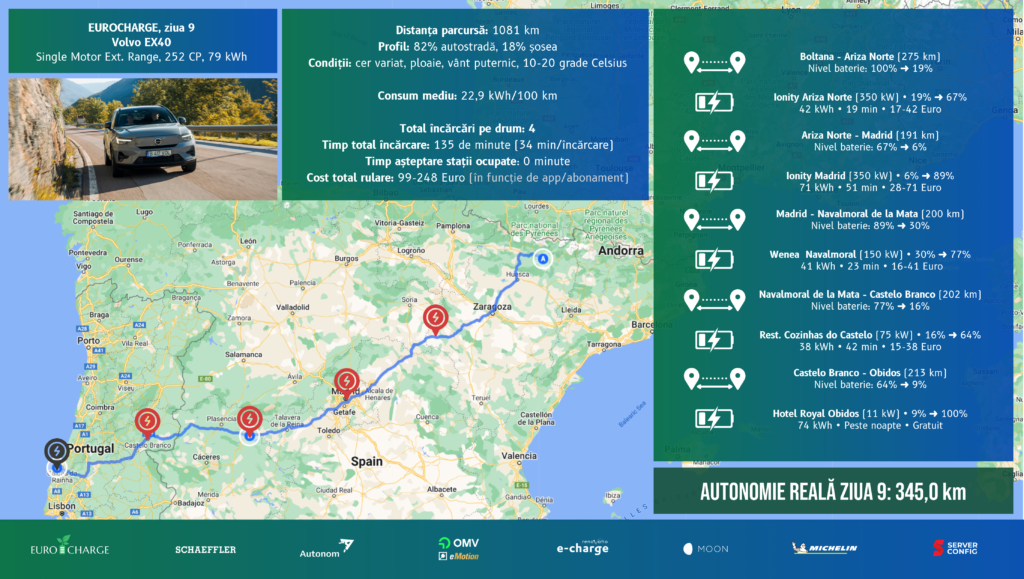
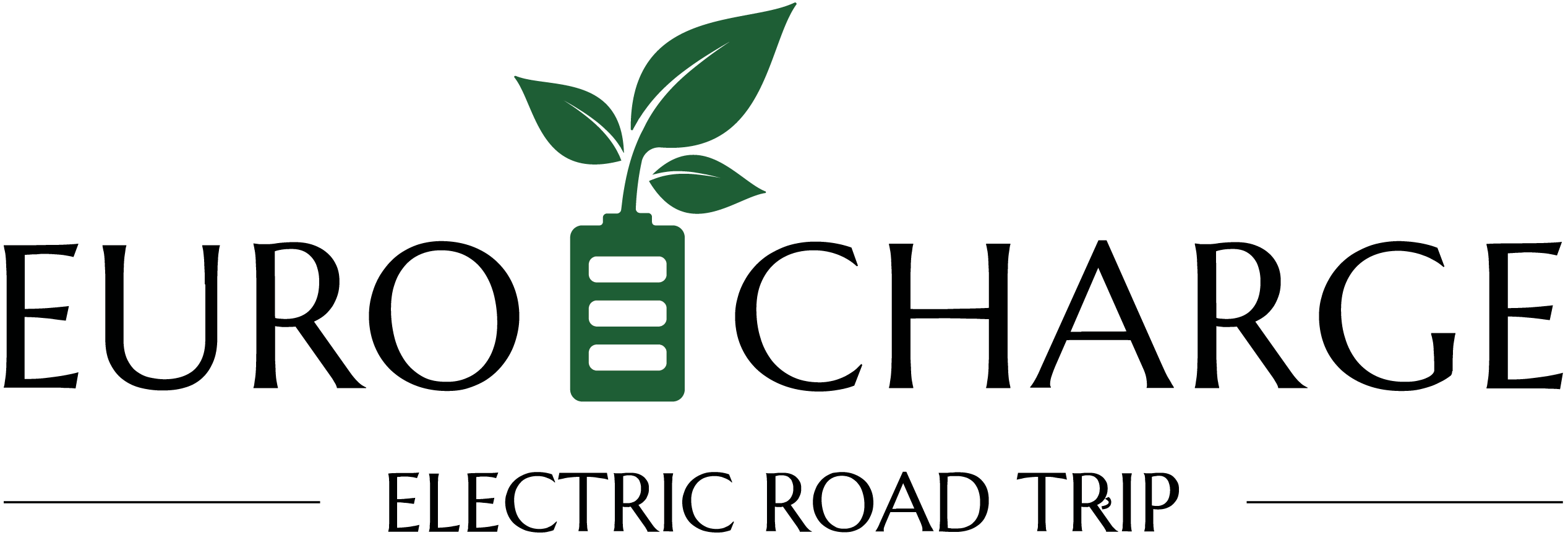
is a project backed by SCHAEFFLER
Charged by
OMV eMotion and Renovatio e-charge
Green Partner
Autonom
Charging stations
MOON România
On the road with
Michelin
Powered by
Server Config

